Paul van Yperen's Blog, page 66
December 5, 2023
The Rescuers (1977)
This december, EFSP presents a series of posts on Disney classics. The Rescuers (John Lounsbery, Wolfgang Reitherman, Art Stevens, 1977) was the 23rd feature film by Walt Disney Animation Studios and the last one of the 1970s. It tells the story of the brave mouse Miss Bianca and the shy janitor Bernard, who both work for the Rescue Aid Society and rescue the kidnapped girl Penny. It was Disney's first major critical and financial success since Jungle Book (1967). It was also the last Disney animated classic film to receive an Oscar nomination until The Little Mermaid (1989), twelve years later.
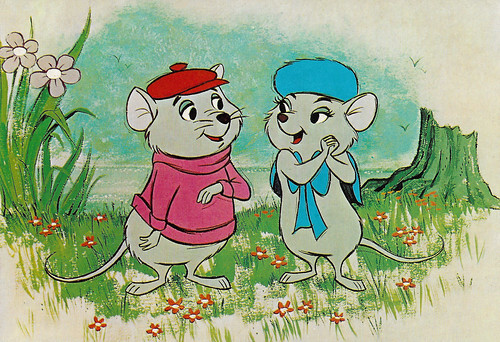
Italian postcard by Grafiche Biondetti, Verona, no. 122 / 4266. Illustration: Walt Disney Productions. Film image of The Rescuers (John Lounsbery, Wolfgang Reitherman, Art Stevens, 1977).
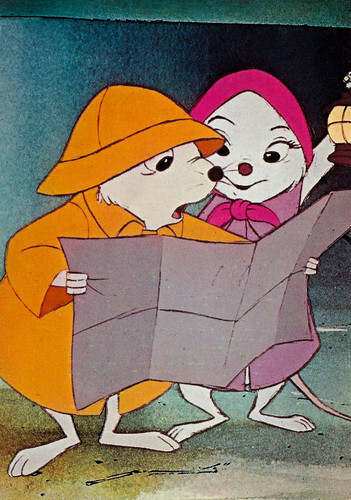
Italian postcard by Grafiche Biondetti, Verona. Illustration: Walt Disney Productions. Film image of The Rescuers (John Lounsbery, Wolfgang Reitherman, Art Stevens, 1977).
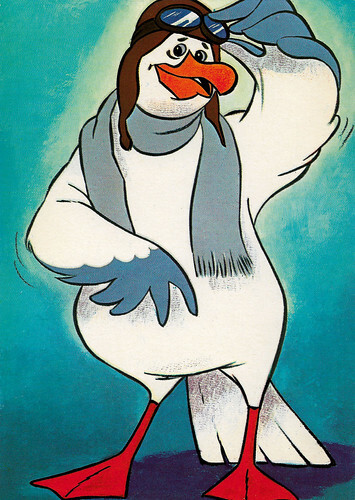
Vintage postcard. Illustration: Walt Disney Productions. Film image of The Rescuers (John Lounsbery, Wolfgang Reitherman, Art Stevens, 1977).
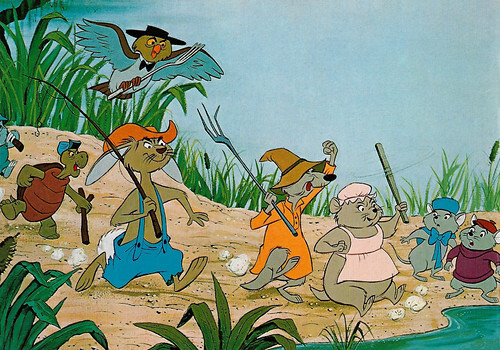
Italian postcard by Grafiche Biondetti srl, Verona, no. 122/3. Illustration: Walt Disney Productions. Film image of The Rescuers (John Lounsbery, Wolfgang Reitherman, Art Stevens, 1977).
The Rescue Aid Society
The Rescuers was something of a gamble for Disney studios at the time as they had been veering away from animation for a decade and had been reliant on live-action films and re-releases for their income. They had come close to totally shutting their animation studios some years earlier. Their few post-Jungle Book (1967) animated feature films like The Aristocats (1970) and Robin Hood (1973) had turned decent but unspectacular profits.
They have also resulted in some criticism for lacking the artistic lavishness & memorability of the classic Disney films of the past. Whilst The Rescuers (1977) also suffered some of the same criticisms, it proved hugely popular at the box office.
The film starts with a young orphan named Penny in an abandoned riverboat in Devil's Bayou, Louisiana. She drops a message in a bottle, containing a plea for help, into the river. This message makes its way to the Rescue Aid Society, a mouse organisation in the basement of the United Nations building dedicated to the rescue and well-being of anyone in need.
The Hungarian representative, Miss Bianca, volunteers to accept the case. She chooses Bernard, a stammering janitor, as her co-agent. Searching for clues at Penny's home at Morningside Orphanage in New York City, the two mice discover that the girl has been kidnapped by the evil pawn shop owner Madame Medusa and her companion Mr. Snoops.
On the back of Orville the albatross, Miss Bianca and Bernard travel to the terrifyingly gloomy Devil's Bayou where they learn the shocking truth: the innocent young girl is being forced down into a dangerous, dark underground pirate's cave where she must find the Devil's Eye, the world's largest diamond and Madame Medusa's greatest obsession. Before returning safely home, Miss Bianca, Bernard, and Penny will have to combat Madame Medusa's two ferocious pet alligators Brutus and Nero with the help of Ellie Mae and Evinrude the dragonfly, as well as survive the raging tides inside the horrible pirate's cave.
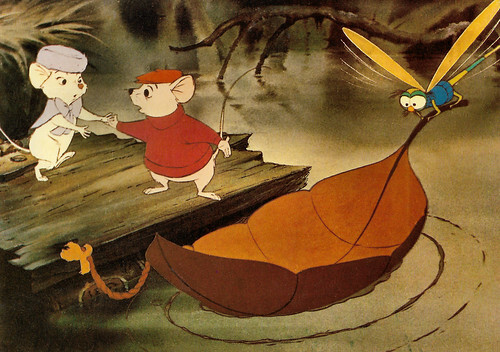
French postcard by Editions G. Picard / La Rose, no. WD 4/31. Illustration: Walt Disney Productions. Film image of The Rescuers (John Lounsbery, Wolfgang Reitherman, Art Stevens, 1977).
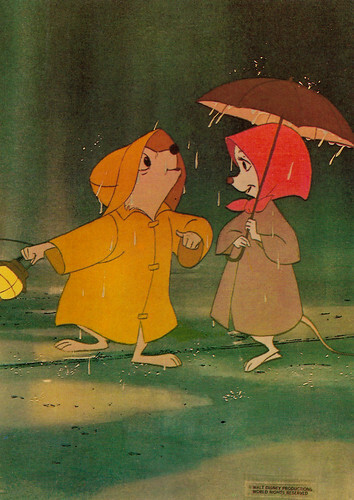
French postcard by Editions G. Picard / La Rose, no. WD 4/32. Illustration: Walt Disney Productions. Film image of The Rescuers (John Lounsbery, Wolfgang Reitherman, Art Stevens, 1977).
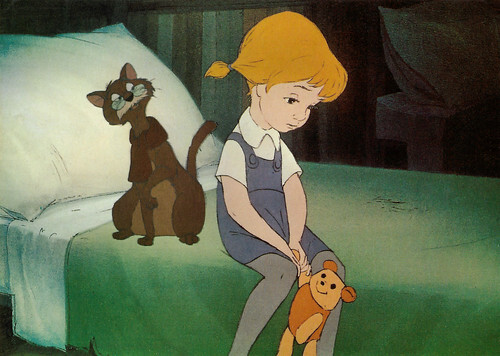
French postcard by Editions G. Picard / La Rose, no. WD 4/34. Illustration: Walt Disney Productions. Film image of The Rescuers (John Lounsbery, Wolfgang Reitherman, Art Stevens, 1977).
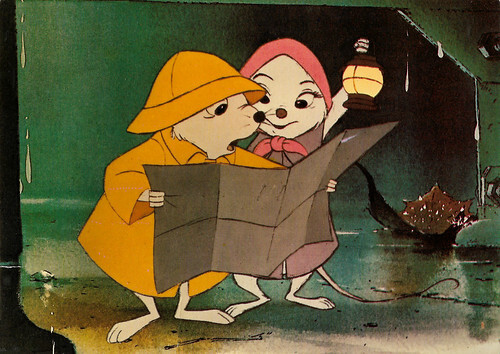
French postcard by Editions G. Picard / La Rose, no. WD 4/35. Illustration: Walt Disney Productions. Film image of The Rescuers (John Lounsbery, Wolfgang Reitherman, Art Stevens, 1977).
Disney's 'Nine Old Men'
The Rescuers is considered by its producers, critics and audiences to be the film that proved that Walt Disney Productions' animation department would survive following the death of Walt Disney. It was the company's first major critical and financial success since Jungle Book (1967), and its last until The Little Mermaid (1989).
The film was one of the last Walt Disney classics to be animated by members of Walt Disney's 'Nine Old Men'. Veteran animator Milt Kahl stated that he enjoyed his work on the film's villain, Madame Medusa, more than that of any of his other assignments. The character's wacky, explosive nature unleashed his ability to create over-the-top, yet believable, expression and movement that the more confined personalities of previous characters prohibited. Kahl took inspiration from his ex-wife, whom he didn't particularly care for, as well as live-action characters from other films, to bring the wicked character to life.
Don Bluth became the first of the new artists trained during the 1970s to be listed as a directing animator. While working on the film, Bluth noted that some of the characters did not have the whites of their eyes coloured in. When he questioned the reason why, he was told that it was too expensive. Bluth and fellow animator Gary Goldman got their own equipment to test if it was true, they found that it was not too expensive. When they reported back with their discovery, the two were told to follow orders and do as they were told. Bluth referred to this as "the straw that broke the camel's back" which would eventually lead to Bluth and Goldman leaving Disney.
The film's final budget was estimated to be $7.5 million, an astronomical amount at the time. Despite its high budget, the film proved a huge success, managing to out-gross strong competition, such as Star Wars: Episode IV: A New Hope (George Lucas, 1977), in several European countries, including France and West Germany. During its initial release in 1977, the film's distributor rentals amounted to 19 million dollars in the United States and Canada, while its international rentals totalled 41 million dollars.
Following two theatrical re-releases in the 1980s, the film's total lifetime worldwide gross is 169 million dollars. According to their publisher, The Rescuers (1977) helped put all nine of British author Margery Sharp's 'The Rescuers' novels on the bestseller lists; not just 'The Rescuers' (1959) and 'Miss Bianca' (1962), on which the film is based. The film's popularity almost led to a spin-off TV series in 1989. When the animation department green-lit The Rescuers Down Under (Hendel Butoy, Mike Gabriel, 1990), the spin-off was reworked into Chip 'n Dale: Rescue Rangers (1989), with Chip and Dale replacing Bernard and Miss Bianca.
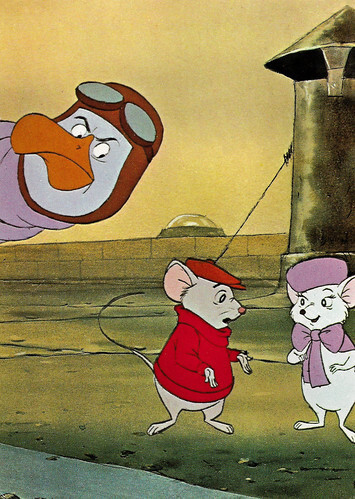
Belgian postcard by Editions Corna, Brussels. Illustration: Walt Disney Productions. Film image of The Rescuers (John Lounsbery, Wolfgang Reitherman, Art Stevens, 1977).
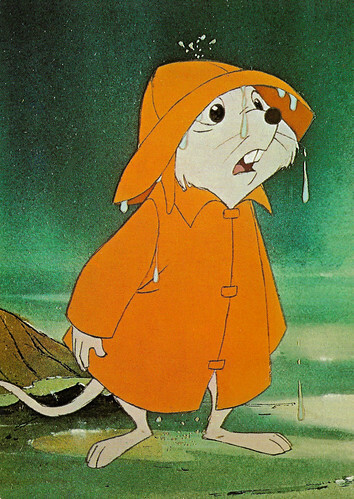
Belgian postcard by Editions Corna, Brussels, sent by mail in 1978. Illustration: Walt Disney Productions. Film image of The Rescuers (John Lounsbery, Wolfgang Reitherman, Art Stevens, 1977).
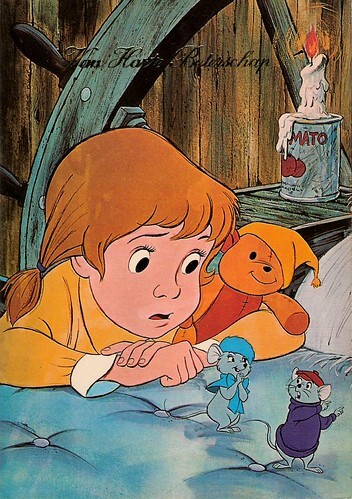
Italian postcard by Grafiche Biondetti, Verona, no. 122, distributed in the Netherlands. Illustration: Walt Disney Productions. Film image of The Rescuers (John Lounsbery, Wolfgang Reitherman, Art Stevens, 1977). Dutch caption: Van Harte Beterschap (Get well soon).
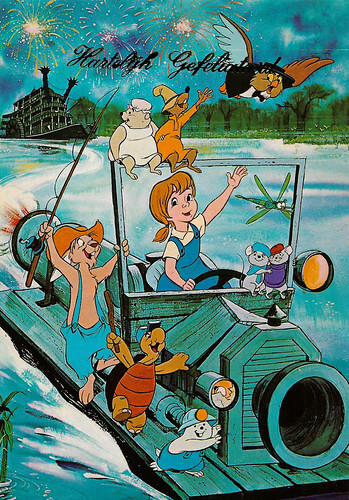
Italian postcard by Grafiche Biondetti, Verona, no. 122, with Dutch text 'Hartelijk gefeliciteerd' (Congratulations). Illustration: Walt Disney Productions. Film image of The Rescuers (John Lounsbery, Wolfgang Reitherman, Art Stevens, 1977).
Sources: Wikipedia and IMDb.

Italian postcard by Grafiche Biondetti, Verona, no. 122 / 4266. Illustration: Walt Disney Productions. Film image of The Rescuers (John Lounsbery, Wolfgang Reitherman, Art Stevens, 1977).

Italian postcard by Grafiche Biondetti, Verona. Illustration: Walt Disney Productions. Film image of The Rescuers (John Lounsbery, Wolfgang Reitherman, Art Stevens, 1977).

Vintage postcard. Illustration: Walt Disney Productions. Film image of The Rescuers (John Lounsbery, Wolfgang Reitherman, Art Stevens, 1977).

Italian postcard by Grafiche Biondetti srl, Verona, no. 122/3. Illustration: Walt Disney Productions. Film image of The Rescuers (John Lounsbery, Wolfgang Reitherman, Art Stevens, 1977).
The Rescue Aid Society
The Rescuers was something of a gamble for Disney studios at the time as they had been veering away from animation for a decade and had been reliant on live-action films and re-releases for their income. They had come close to totally shutting their animation studios some years earlier. Their few post-Jungle Book (1967) animated feature films like The Aristocats (1970) and Robin Hood (1973) had turned decent but unspectacular profits.
They have also resulted in some criticism for lacking the artistic lavishness & memorability of the classic Disney films of the past. Whilst The Rescuers (1977) also suffered some of the same criticisms, it proved hugely popular at the box office.
The film starts with a young orphan named Penny in an abandoned riverboat in Devil's Bayou, Louisiana. She drops a message in a bottle, containing a plea for help, into the river. This message makes its way to the Rescue Aid Society, a mouse organisation in the basement of the United Nations building dedicated to the rescue and well-being of anyone in need.
The Hungarian representative, Miss Bianca, volunteers to accept the case. She chooses Bernard, a stammering janitor, as her co-agent. Searching for clues at Penny's home at Morningside Orphanage in New York City, the two mice discover that the girl has been kidnapped by the evil pawn shop owner Madame Medusa and her companion Mr. Snoops.
On the back of Orville the albatross, Miss Bianca and Bernard travel to the terrifyingly gloomy Devil's Bayou where they learn the shocking truth: the innocent young girl is being forced down into a dangerous, dark underground pirate's cave where she must find the Devil's Eye, the world's largest diamond and Madame Medusa's greatest obsession. Before returning safely home, Miss Bianca, Bernard, and Penny will have to combat Madame Medusa's two ferocious pet alligators Brutus and Nero with the help of Ellie Mae and Evinrude the dragonfly, as well as survive the raging tides inside the horrible pirate's cave.

French postcard by Editions G. Picard / La Rose, no. WD 4/31. Illustration: Walt Disney Productions. Film image of The Rescuers (John Lounsbery, Wolfgang Reitherman, Art Stevens, 1977).

French postcard by Editions G. Picard / La Rose, no. WD 4/32. Illustration: Walt Disney Productions. Film image of The Rescuers (John Lounsbery, Wolfgang Reitherman, Art Stevens, 1977).

French postcard by Editions G. Picard / La Rose, no. WD 4/34. Illustration: Walt Disney Productions. Film image of The Rescuers (John Lounsbery, Wolfgang Reitherman, Art Stevens, 1977).

French postcard by Editions G. Picard / La Rose, no. WD 4/35. Illustration: Walt Disney Productions. Film image of The Rescuers (John Lounsbery, Wolfgang Reitherman, Art Stevens, 1977).
Disney's 'Nine Old Men'
The Rescuers is considered by its producers, critics and audiences to be the film that proved that Walt Disney Productions' animation department would survive following the death of Walt Disney. It was the company's first major critical and financial success since Jungle Book (1967), and its last until The Little Mermaid (1989).
The film was one of the last Walt Disney classics to be animated by members of Walt Disney's 'Nine Old Men'. Veteran animator Milt Kahl stated that he enjoyed his work on the film's villain, Madame Medusa, more than that of any of his other assignments. The character's wacky, explosive nature unleashed his ability to create over-the-top, yet believable, expression and movement that the more confined personalities of previous characters prohibited. Kahl took inspiration from his ex-wife, whom he didn't particularly care for, as well as live-action characters from other films, to bring the wicked character to life.
Don Bluth became the first of the new artists trained during the 1970s to be listed as a directing animator. While working on the film, Bluth noted that some of the characters did not have the whites of their eyes coloured in. When he questioned the reason why, he was told that it was too expensive. Bluth and fellow animator Gary Goldman got their own equipment to test if it was true, they found that it was not too expensive. When they reported back with their discovery, the two were told to follow orders and do as they were told. Bluth referred to this as "the straw that broke the camel's back" which would eventually lead to Bluth and Goldman leaving Disney.
The film's final budget was estimated to be $7.5 million, an astronomical amount at the time. Despite its high budget, the film proved a huge success, managing to out-gross strong competition, such as Star Wars: Episode IV: A New Hope (George Lucas, 1977), in several European countries, including France and West Germany. During its initial release in 1977, the film's distributor rentals amounted to 19 million dollars in the United States and Canada, while its international rentals totalled 41 million dollars.
Following two theatrical re-releases in the 1980s, the film's total lifetime worldwide gross is 169 million dollars. According to their publisher, The Rescuers (1977) helped put all nine of British author Margery Sharp's 'The Rescuers' novels on the bestseller lists; not just 'The Rescuers' (1959) and 'Miss Bianca' (1962), on which the film is based. The film's popularity almost led to a spin-off TV series in 1989. When the animation department green-lit The Rescuers Down Under (Hendel Butoy, Mike Gabriel, 1990), the spin-off was reworked into Chip 'n Dale: Rescue Rangers (1989), with Chip and Dale replacing Bernard and Miss Bianca.

Belgian postcard by Editions Corna, Brussels. Illustration: Walt Disney Productions. Film image of The Rescuers (John Lounsbery, Wolfgang Reitherman, Art Stevens, 1977).

Belgian postcard by Editions Corna, Brussels, sent by mail in 1978. Illustration: Walt Disney Productions. Film image of The Rescuers (John Lounsbery, Wolfgang Reitherman, Art Stevens, 1977).

Italian postcard by Grafiche Biondetti, Verona, no. 122, distributed in the Netherlands. Illustration: Walt Disney Productions. Film image of The Rescuers (John Lounsbery, Wolfgang Reitherman, Art Stevens, 1977). Dutch caption: Van Harte Beterschap (Get well soon).

Italian postcard by Grafiche Biondetti, Verona, no. 122, with Dutch text 'Hartelijk gefeliciteerd' (Congratulations). Illustration: Walt Disney Productions. Film image of The Rescuers (John Lounsbery, Wolfgang Reitherman, Art Stevens, 1977).
Sources: Wikipedia and IMDb.
Published on December 05, 2023 22:00
December 4, 2023
Elisa Severi
Elisa Severi (1872-1930) was an Italian stage and screen actress, who after a prolific career on stage in the 1900s, expanded this with an additional silent film career in the 1910s and early 1920s.
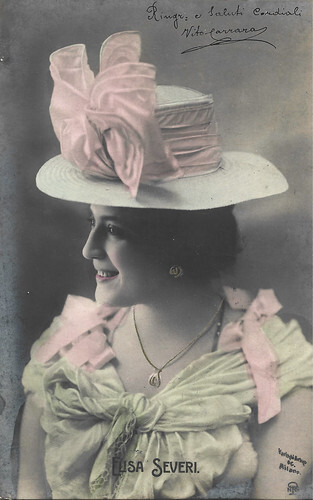
Italian postcard by NPG, no. 3. Photo: Varischi Artico & Co., Milano.
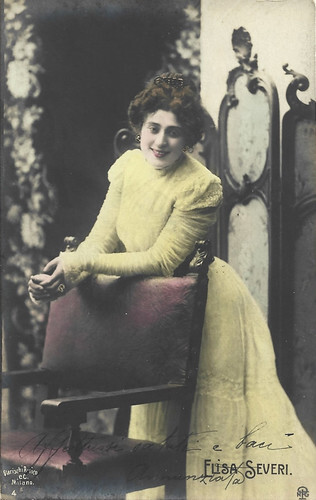
Italian postcard by NPG, no. 4. Photo: Varischi Artico & C., Milano.
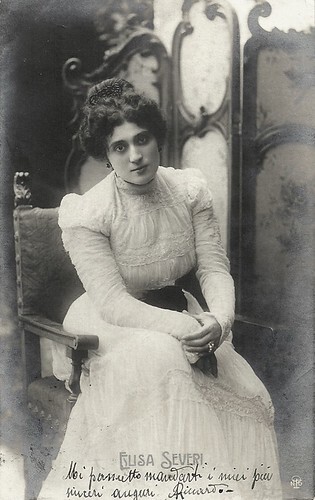
Italian postcard by NPG. Photo: Varischi Artico & Co., Milano.
A splendid creature vibrating with a sentimental passion
Elisa Severi was born in1872 in Ravenna, Emilia-Romagna, Italy. She trained as an actress in Rome, where she debuted in the 1889-1890 season. She joined the Drammatica Compagnia Palladini-Talli in 1894, and headed a company with Oreste Calabresi for the 1905-1906 season, with Mercedes Brignone as one of the company's other actresses. In the 1900s Severi was a popular stage actress. She became a member of Ettore Berti's Compagnia Stabile Romana in 1912. A reviewer of her stage work called her "una splendida creatura vibrante di passione sentida" (A splendid creature vibrating with a sentimental passion).
Between 1913 and 1921, Severi appeared in twenty silent films. She made her film debut in the Film d'Arte Italiana (FAI) production La rinunzia (Ugo Falena, 1913). Alfonsina Pieri played the female lead as the wife and muse of a poet (Ettore Berti), whose stage play became a success. The poet falls in love with the leading actress, Liliana (Severi), who inspires him to write 'La Rinunzia' (The Renunciation), a drama about a wife who sacrifices herself for the glory of her husband... Pieri, Berti and Severi were all praised in the Italian press.
Severi left Berti and FAI and moved to the Turinese company Gloria, where she starred in five films. Alberto degli Abbati directed her in Circe moderna (Alberto degli Abbati, 1914), which was critically reviewed, while there was praise instead for Abbati's La contessa Fedra (Alberto degli Abbati, 1914), though the press found Severi's co-actor Carlo Gervasio overacting. Severi remained at Gloria for more leads in La corsa all'amore (Telemaco Ruggeri, 1914) and Il diritto di uccidere (Amleto Palermi, 1914). Severi did one last film at Gloria, Il bacio di sirena (Guido Di Nardo, 1915), with Mario Bonnard, who was Severi's partner in several Gloria films.
During the First World War years (1916-1918), Severi did only a handful of lesser-known films for Latin Ars, Cosmopoli Film, and Tespi Film, but after the war she acted as Herodias in Carmine Gallone's major production for Medusa Film, Redenzione/Redemption (Carmine Gallone, 1919), starring Diana Karenne as Mary Magdalene, Alberto Pasquali as Jesus, and Pepa Bonafé as Salome. Severi stayed with Gallone for his Amleto e il suo clown/On with the Motley (Carmine Gallone, 1920) in which she played the mother of the star, Soava Gallone . Her last films were for the companies Libertas, Nova Film and Unione Cinematografica Italiana, e.g. Dopo il suicidio (Giulio Antamoro, 1920) with Fernanda Negri Pouget , L'erma biffronte (Alberto Carlo Lolli, 1920) with Tilde Kassay and Lido Manetti , and lastly, Sublime rinuncia (Mario Corte, 1921), with Carlo and Olga Benetti .
In 1910, Elisa Severi had one son, editor and translator Giorgio, with journalist, editor and writer Tomaso Monicelli (1883-1946). Giorgio coined the Italian word 'fantascienza' for the Science-Fiction magazine Urania. In 1913 Tomaso Monicelli married Maria Carreri and had five children with her, among whom the famous film director Mario Monicelli. Elisa Severi died in 1930 in Rome at the age of 58. A park in Ravenna is named for her.
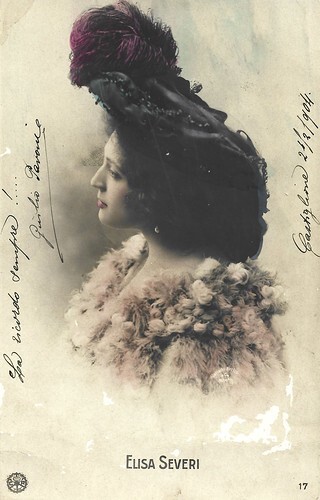
Italian postcard by C.R. (Compagnia Rotografica, Milano), no. 17. Postcard mailed 21-2-1904. Backside: N.P.G., Diffida.
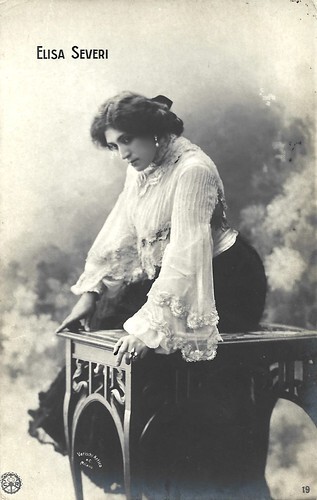
Italian postcard by CR, no. 19. Photo: Varischi Artico & Co., Milano.
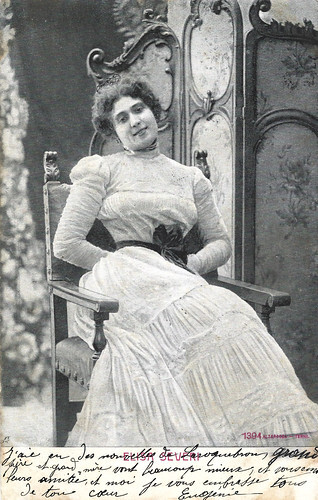
Italian postcard by Alterocca, Terni, no. 1394.
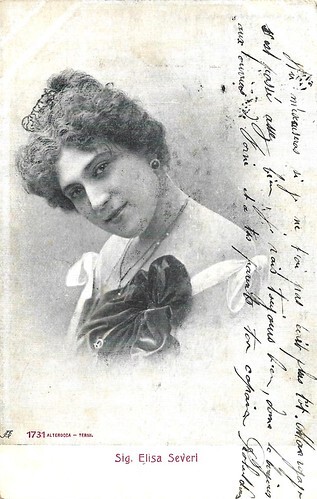
Italian postcard by Alterocca, Terni, no. 1731.
Sources: Vittorio Martinelli (Il cinema muto italiano), Wikipedia (English and Italian) and .

Italian postcard by NPG, no. 3. Photo: Varischi Artico & Co., Milano.

Italian postcard by NPG, no. 4. Photo: Varischi Artico & C., Milano.

Italian postcard by NPG. Photo: Varischi Artico & Co., Milano.
A splendid creature vibrating with a sentimental passion
Elisa Severi was born in1872 in Ravenna, Emilia-Romagna, Italy. She trained as an actress in Rome, where she debuted in the 1889-1890 season. She joined the Drammatica Compagnia Palladini-Talli in 1894, and headed a company with Oreste Calabresi for the 1905-1906 season, with Mercedes Brignone as one of the company's other actresses. In the 1900s Severi was a popular stage actress. She became a member of Ettore Berti's Compagnia Stabile Romana in 1912. A reviewer of her stage work called her "una splendida creatura vibrante di passione sentida" (A splendid creature vibrating with a sentimental passion).
Between 1913 and 1921, Severi appeared in twenty silent films. She made her film debut in the Film d'Arte Italiana (FAI) production La rinunzia (Ugo Falena, 1913). Alfonsina Pieri played the female lead as the wife and muse of a poet (Ettore Berti), whose stage play became a success. The poet falls in love with the leading actress, Liliana (Severi), who inspires him to write 'La Rinunzia' (The Renunciation), a drama about a wife who sacrifices herself for the glory of her husband... Pieri, Berti and Severi were all praised in the Italian press.
Severi left Berti and FAI and moved to the Turinese company Gloria, where she starred in five films. Alberto degli Abbati directed her in Circe moderna (Alberto degli Abbati, 1914), which was critically reviewed, while there was praise instead for Abbati's La contessa Fedra (Alberto degli Abbati, 1914), though the press found Severi's co-actor Carlo Gervasio overacting. Severi remained at Gloria for more leads in La corsa all'amore (Telemaco Ruggeri, 1914) and Il diritto di uccidere (Amleto Palermi, 1914). Severi did one last film at Gloria, Il bacio di sirena (Guido Di Nardo, 1915), with Mario Bonnard, who was Severi's partner in several Gloria films.
During the First World War years (1916-1918), Severi did only a handful of lesser-known films for Latin Ars, Cosmopoli Film, and Tespi Film, but after the war she acted as Herodias in Carmine Gallone's major production for Medusa Film, Redenzione/Redemption (Carmine Gallone, 1919), starring Diana Karenne as Mary Magdalene, Alberto Pasquali as Jesus, and Pepa Bonafé as Salome. Severi stayed with Gallone for his Amleto e il suo clown/On with the Motley (Carmine Gallone, 1920) in which she played the mother of the star, Soava Gallone . Her last films were for the companies Libertas, Nova Film and Unione Cinematografica Italiana, e.g. Dopo il suicidio (Giulio Antamoro, 1920) with Fernanda Negri Pouget , L'erma biffronte (Alberto Carlo Lolli, 1920) with Tilde Kassay and Lido Manetti , and lastly, Sublime rinuncia (Mario Corte, 1921), with Carlo and Olga Benetti .
In 1910, Elisa Severi had one son, editor and translator Giorgio, with journalist, editor and writer Tomaso Monicelli (1883-1946). Giorgio coined the Italian word 'fantascienza' for the Science-Fiction magazine Urania. In 1913 Tomaso Monicelli married Maria Carreri and had five children with her, among whom the famous film director Mario Monicelli. Elisa Severi died in 1930 in Rome at the age of 58. A park in Ravenna is named for her.

Italian postcard by C.R. (Compagnia Rotografica, Milano), no. 17. Postcard mailed 21-2-1904. Backside: N.P.G., Diffida.

Italian postcard by CR, no. 19. Photo: Varischi Artico & Co., Milano.

Italian postcard by Alterocca, Terni, no. 1394.

Italian postcard by Alterocca, Terni, no. 1731.
Sources: Vittorio Martinelli (Il cinema muto italiano), Wikipedia (English and Italian) and .
Published on December 04, 2023 22:00
December 3, 2023
Julie Christie
Smart and sexy Julie Christie (1941) is an icon of the new British cinema. During the Swinging Sixties, she became a superstar with roles like Lara in the worldwide smash hit Doctor Zhivago (1965). Since then she has won the Oscar, the Golden Globe, the BAFTA, and the Screen Actors Guild Awards.

Spanish postcard by Postal Oscar Color S.A., no. 623, Hospitalet (Barcelona).
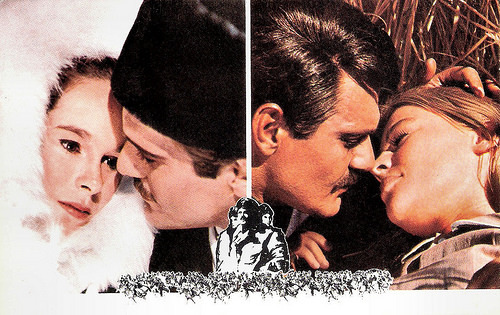
American postcard. Photo: MGM. Photo: publicity stills for Dr. Zhivago (David Lean, 1965) with Geraldine Chaplin, Omar Sharif and Julie Christie.
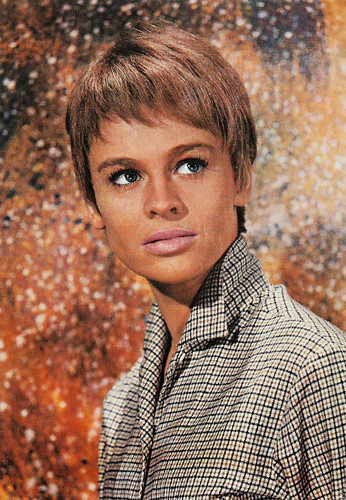
French postcard by E.D.U.G., no. 484. Photo: Atlantic Press. Julie Christie in Fahrenheit 451 (François Truffaut, 1966).
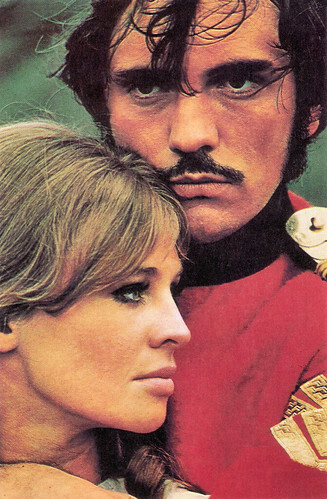
Romanian postcard by Casa Filmului Acin, no. 86. Julie Christie and Terence Stamp in Far from the Madding Crowd (John Schlesinger, 1967).
The It Girl of the Swinging Sixties
Julie Frances Christie was born in 1941 in Chabua, Assam Province, British India (now Assam, India). She was the daughter of Frank St. John Christie, a tea planter, and his Welsh wife Rosemary (née Ramsden), who was a painter. Her younger brother, Clive Christie, would become a professor of Southeast Asian studies at Hull University. They grew up on their father's tea plantation in Assam. At 7, Julie was sent to England for her education.
As a teenager at Wycombe Court School, she played the role of the Dauphin in a school production of George Bernard Shaw's Saint Joan. A fascination with the artist's lifestyle led to her enrolling in London's Central School of Speech and Drama training. Christie made her stage debut as a member of the Frinton Repertory of Essex in 1957. One of her first roles was playing Anne Frank in a London theatrical production of The Diary of Anne Frank.
Christie was not fond of the stage, even though it allowed her to travel, including a professional gig in the United States. She made her TV debut as an artificial girl created from the DNA of a deceased science lab assistant in the BBC Sci-Fi series A for Andromeda (Michael Hayes, 1961). Her first film appearance was a bit part in the amusing comedy Crooks Anonymous (Ken Annakin, 1962), which was followed up by a larger ingénue role in the romantic comedy The Fast Lady (Ken Annakin, 1963) with Stanley Baker .
Christie first worked with the man who would kick her career into high gear, director John Schlesinger, when he chose her as a replacement for the actress (Topsy Jane) originally cast in Billy Liar (John Schlesinger, 1963). Christie's turn in the film as the free-wheeling Liz, the supremely confident friend and love interest to Tom Courtenay's full-time dreamer Billy, was a stunner, and she had her first taste of becoming an icon of the new British cinema. Her screen presence was such that the great John Ford cast her as the young prostitute Daisy Battles in Young Cassidy (Jack Cardiff, John Ford, 1965), a biopic about Irish playwright Sean O'Casey.
She made her breakthrough to super-stardom in Schlesinger's seminal Swinging Sixties film Darling (John Schlesinger, 1965). Schlesinger called on Christie to play the role of the manipulative young actress and jet-setter Diana Scott when the casting of Shirley MacLaine fell through. As played by Christie, Diana is an amoral social butterfly who undergoes a metamorphosis from an immature sex kitten to a jaded socialite. For her complex performance, Christie won raves, including the Best Actress Oscar and the Best Actress BAFTA. Her image as the It Girl of the Swinging Sixties was further cemented by her appearance in the documentary Tonite Let's All Make Love in London (Peter Whitehead, 1967), which covered the hipster scene in England.
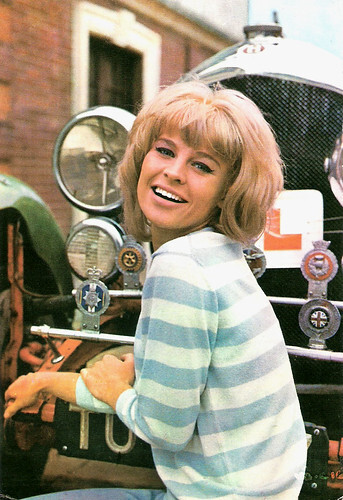
Spanish postcard by Raker, no. 1127. Photo: publicity still for The Fast Lady (1963).
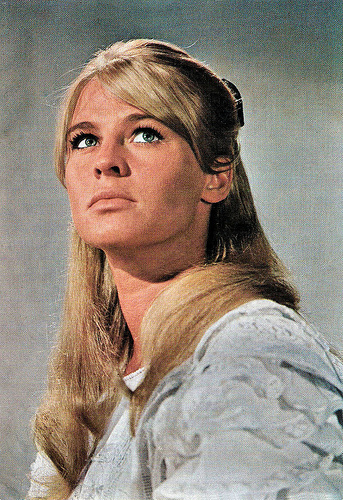
Italian postcard by Rotalcolor, Milano, no. 273.
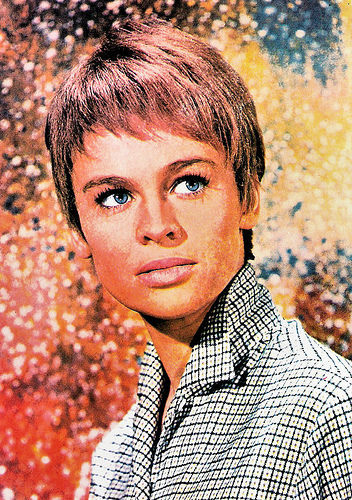
French postcard by E.D.U.G., no. 484. Photo: Atlantic Press.
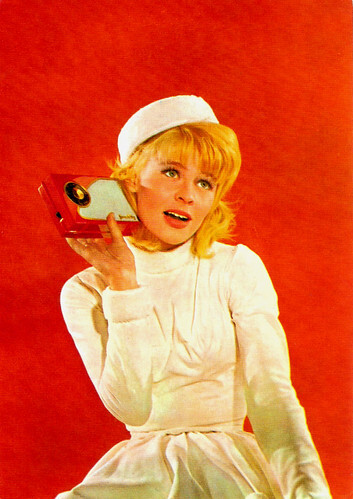
Romanian postcard by Casa Filmului Acin, no. 554.
One of the all-time box-office champs
Julie Christie followed up Darling (1965) with the role of the tragic Lara Antipova in the two-time Academy Award-winning Doctor Zhivago (David Lean, 1965). Lean’s epic adaptation of Boris Pasternak's novel became one of the all-time box-office champs. Christie was now a superstar who commanded a price of $400,000 per picture.
More interested in film as an art form than in consolidating her movie stardom, Christie followed up Doctor Zhivago (1965) with a dual role in Fahrenheit 451 (1966) for Francois Truffaut, a Nouvelle Vague director she admired. The film was, according to Jon C. Hopwood at IMDb , "hurt by the director's lack of English and by friction between Truffaut and Christie's male co-star Oskar Werner , who had replaced the more-appropriate-for-the-role Terence Stamp ".
Stamp and Christie had been lovers before she had become famous, and he was unsure he could act with her, due to his own ego problems. On his part, Werner resented the attention the smitten Truffaut gave Christie. Stamp overcame those ego problems to sign on as her co-star in John Schlesinger's adaptation of Thomas Hardy's Far from the Madding Crowd (John Schlesinger, 1967), which also starred Peter Finch and Alan Bates . Jon C. Hopwood at IMDb : “It is a film that is far better remembered now than when it was received in 1967. The film and her performance as the Hardy heroine Bathsheba Everdene was lambasted by film critics, many of whom faulted Christie for being too ‘mod’ and thus untrue to one of Hardy's classic tales of fate.”
She then met the man who transformed her life, undermining her pretensions to a career as a film star in their seven-year-long love affair, the American actor Warren Beatty. Living his life was always far more important than being a star for Beatty, who viewed the movie star profession as a 'treadmill leading to more treadmills' and who was wealthy enough after Bonnie and Clyde (Arthur Penn, 1967) to not have to ever work again. Christie and Beatty had visited a working farm during the production of Far from the Madding Crowd (1967) and had been appalled by the industrial exploitation of the animals. After that, animal rights became a very important subject to Christie. They were kindred souls who remained friends four decades after their affair ended in 1974.
Christie's last box-office hit in which she was the top liner was Petulia (Richard Lester, 1968), a romantic drama about the romance between a staid doctor (George C. Scott) and a flighty but vulnerable socialite (Christie). According to Jon C. Hopwood, it is “a film that featured one of co-star George C. Scott's greatest performances, perfectly counter-balanced by Christie's portrayal of an ‘arch-kook’ who was emblematic of the 1960s. It is one of the major films of the decade, an underrated masterpiece." Despite the presence of Scott and Shirley Knight, Hopwood claims that the film would not work without Julie Christie. "There is frankly no other actress who could have filled the role, bringing that unique presence and the threat of danger that crackled around Christie's electric aura. At this point of her career, she was poised for greatness as a star, greatness as an actress.”
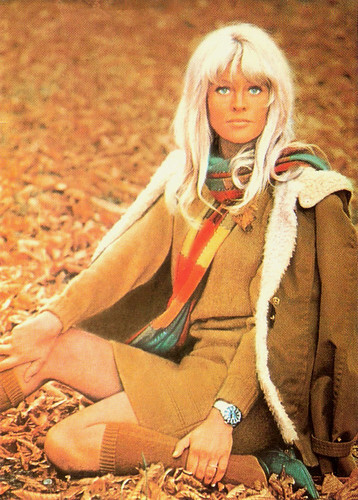
Romanian postcard by Casa Filmului Acin, no. 277.
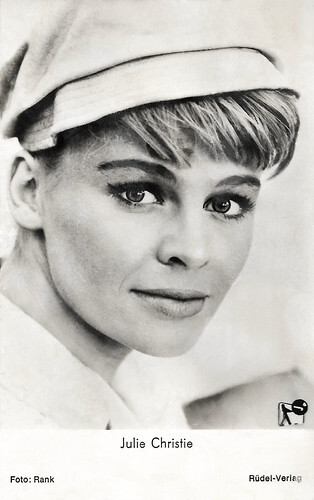
West German postcard by Rüdel-Verlag, Hamburg, no. 4917. Photo: Rank. Julie Christie in Darling (John Schlesinger, 1965).
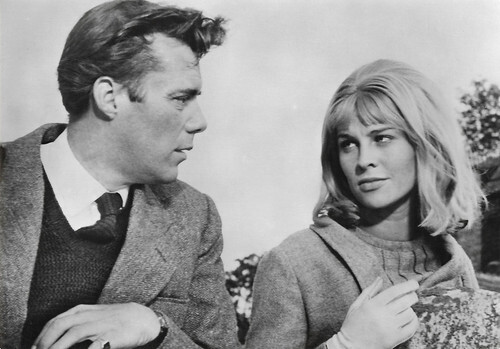
Czech postcard by Pressfoto, Praha, no. 4917. Photo: UTPF / Rank. Julie Christie and Dirk Bogarde in Darling (John Schlesinger, 1965).
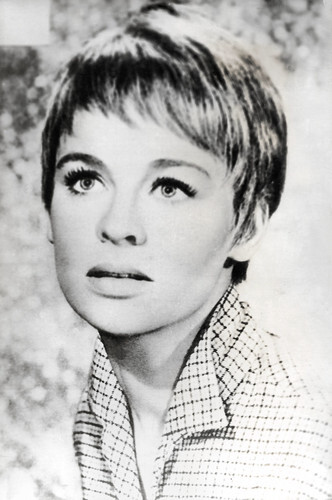
Vintage card. Julie Christie in Fahrenheit 451 (François Truffaut, 1966).
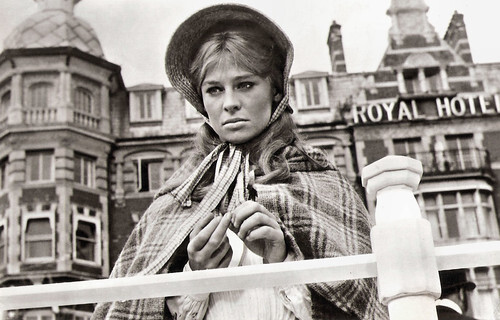
Romanian postcard by Casa Filmului Acin, no. 587. Julie Christie in Far from the Madding Crowd (John Schlesinger, 1967). The hotel in the back is the Royal Hotel in Weymouth, Dorset, UK.
Dazzling mystery-horror film
After meeting Beatty, Julie Christie essentially surrendered any aspirations to screen stardom, or to maintaining herself as a top-drawer working actress. She turned down the lead in They Shoot Horses, Don't They? (Sydney Pollack, 1969) and Anne of the Thousand Days (Charles Jarrott, 1969), two parts that garnered Oscar nominations for the second choices, Jane Fonda and Geneviève Bujold.
After shooting In Search of Gregory (Peter Wood, 1969), a critical and box office flop, to fulfil her contractual obligations, she spent her time with Beatty in California, renting a beach house in Malibu. She did return to form as the bored upper-class woman who ruins a boy's life by involving him in her sexual duplicities, in The Go-Between (Joseph Losey, 1970), written by playwright Harold Pinter.
She won her second Oscar nomination for her role as a brothel 'madam' in Robert Altman's Western drama McCabe & Mrs. Miller (1971) that she made with her lover Beatty. Christie also turned down the role of the Russian Empress in Nicholas and Alexandra (Franklin J. Schaffner, 1971), another film that won the second-choice (Janet Suzman) a Best Actress Oscar nomination.
Two years later, she appeared in the dazzling mystery-horror film Don't Look Now (Nicolas Roeg, 1973), with its famously erotic love scenes between Christie and Donald Sutherland. Director Nicolas Roeg had been her cinematographer on Fahrenheit 451 (1966), Far from the Madding Crowd (1967) and Petulia (1968).
In the mid-1970s, her affair with Beatty came to an end, but the two remained close friends and worked together in Shampoo (Hal Ashby, 1975) and the comedy Heaven Can Wait (Buck Henry, Warren Beatty, 1978). Christie turned down the part of Louise Bryant in Reds (Warren Beatty, 1981), a part written by Beatty with her in mind, as Christie felt an American should play the role. Beatty's then-lover, Diane Keaton, played the part and won a Best Actress Oscar nomination. Other interesting roles she turned down were parts in Rosemary's Baby (Roman Polanski, 1968), The Godfather (Francis Ford Coppola, 1972), Chinatown (Roman Polanski, 1974), Marathon Man (John Schlesinger, 1976), and American Gigolo (Paul Schrader, 1980).
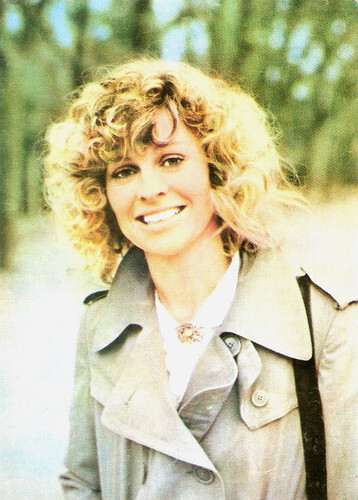
Romanian postcard by Casa Filmului Acin, no. 43 072.
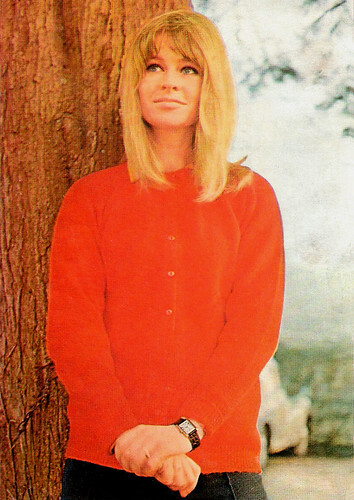
Romanian postcard by Casa Filmului Acin, no. 43 072.
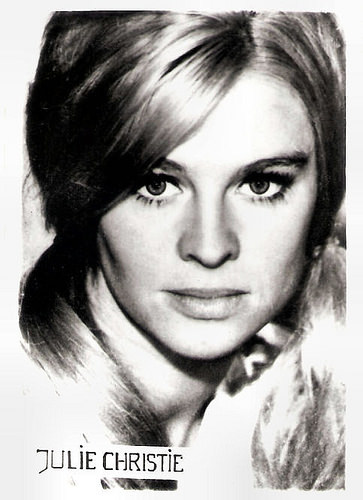
Small Romanian collectors card.
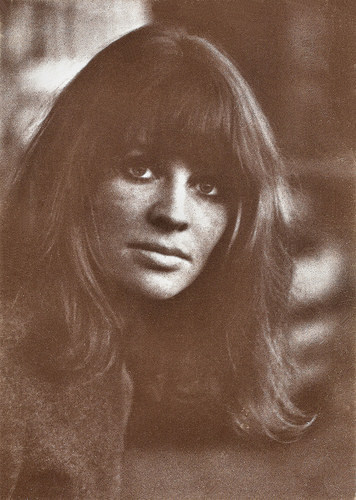
French postcard by Travelling Editions, Paris, no. CP 52. Caption: Julie Christie in 1967.
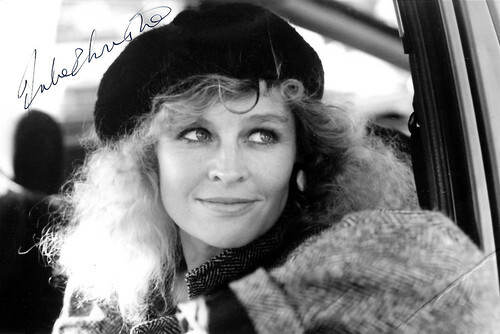
Vintage autograph card.
The British answer to Jane Fonda
Julie Christie moved back to the UK and became 'the British answer to Jane Fonda ', campaigning for various social and political causes, including animal rights and nuclear disarmament. She was greatly in demand but became even more choosy about her roles as her political awareness increased. Her sporadic film commitments reflected her political consciousness such as the animal rights documentary The Animals Film (Victor Schonfeld, 1981), and the feature The Gold Diggers (Sally Potter, 1983), a feminist reinterpretation of film history. Roles in The Return of the Soldier (Alan Bridges, 1982) with Alan Bates and Glenda Jackson , and Merchant-Ivory's Heat and Dust (James Ivory, 1983) seemed to herald a return to form, but then she essentially retired.
A career renaissance came in the mid-1990s with her turn as Queen Gertrude in Kenneth Branagh's adaptation of William Shakespeare ’s Hamlet (Kenneth Branagh, 1996). More rave notices brought her turn as the faded movie star married to handyman Nick Nolte and romanced by a younger man (Jonny Lee Miller) in Afterglow (Alan Rudolph, 1997). She received her third Best Actress Oscar nomination for her performance and showed up at the awards as radiant and uniquely beautiful as ever. Christie lived with left-wing investigative journalist Duncan Campbell (a Manchester Guardian columnist) since 1979, before marrying in 2008. In addition to her film work, she has narrated many books on tape. In 1995, she made a triumphant return to the stage in a London revival of Harold Pinter's Old Times, which garnered her superb reviews.
In the decade since Afterglow (1997), she has worked steadily on film in supporting roles. She worked three times with director-screenwriter and actress Sarah Polley: co-starring with Polley in No Such Thing (Hal Hartley, 2001) and the Goya Award-winning La Vida secreta de las palabras/The Secret Life of Words (Isabel Coixet, 2005), and taking the lead in Polley's first feature film as a director, Away from Her (Sarah Polley, 2006). Christie made a brief appearance in the third Harry Potter film, Harry Potter and the Prisoner of Azkaban (Alfonso Cuarón, 2004), playing Madam Rosmerta, the landlady of the Three Broomsticks pub. That same year, she also appeared in two other high-profile films: Wolfgang Petersen's historical epic Troy (2004) and Marc Forster's Finding Neverland (2004), playing Kate Winslet 's mother. The latter performance earned Christie a BAFTA nomination as a supporting actress in a film.
In 2008, Christie narrated Uncontacted Tribes, a short film for the British-based charity Survival International, featuring previously unseen footage of remote and endangered peoples. She has been a long-standing supporter of the charity, and in February 2008, was named as its first 'Ambassador'. She appeared in a segment of the anthology film New York, I Love You (2008), written by Anthony Minghella, directed by Shekhar Kapur and co-starring Shia LaBeouf. She also played in Glorious 39 (Stephen Poliakoff, 2008), about a British family at the start of World War II.
In 2011, Christie played a 'sexy, bohemian' version of the grandmother role in a gothic retelling of Red Riding Hood (Catherine Hardwicke, 2011) with Amanda Seyfried in the title role. Then followed the political thriller The Company You Keep (Robert Redford, 2012), where she co-starred with Robert Redford . Since then, she has only been the narrator of The Bookshop (Isabel Coixet, 2017) with Emily Mortimer. We conclude this bio with an observation of Brian McFarlane in The Encyclopedia of British Cinema : “Arguably the most genuinely glamorous, and one of the most intelligent, of all British stars, Julie Christie brought a gust of new, sensual life into British cinema.”
Trailer for Doctor Zhivago (1965). Source: ccoruja (YouTube).
Trailer of Petulia (1968). Source: The Grumpy Monk (YouTube).
Trailer Shampoo (1975). Source: Video Detective (YouTube).
Trailer for Away From Her (2006). Source: Lion's Gate (YouTube).
Sources: (IMDb), Brian McFarlane (Encyclopedia of British Cinema), TCM, Wikipedia, and .

Spanish postcard by Postal Oscar Color S.A., no. 623, Hospitalet (Barcelona).

American postcard. Photo: MGM. Photo: publicity stills for Dr. Zhivago (David Lean, 1965) with Geraldine Chaplin, Omar Sharif and Julie Christie.

French postcard by E.D.U.G., no. 484. Photo: Atlantic Press. Julie Christie in Fahrenheit 451 (François Truffaut, 1966).

Romanian postcard by Casa Filmului Acin, no. 86. Julie Christie and Terence Stamp in Far from the Madding Crowd (John Schlesinger, 1967).
The It Girl of the Swinging Sixties
Julie Frances Christie was born in 1941 in Chabua, Assam Province, British India (now Assam, India). She was the daughter of Frank St. John Christie, a tea planter, and his Welsh wife Rosemary (née Ramsden), who was a painter. Her younger brother, Clive Christie, would become a professor of Southeast Asian studies at Hull University. They grew up on their father's tea plantation in Assam. At 7, Julie was sent to England for her education.
As a teenager at Wycombe Court School, she played the role of the Dauphin in a school production of George Bernard Shaw's Saint Joan. A fascination with the artist's lifestyle led to her enrolling in London's Central School of Speech and Drama training. Christie made her stage debut as a member of the Frinton Repertory of Essex in 1957. One of her first roles was playing Anne Frank in a London theatrical production of The Diary of Anne Frank.
Christie was not fond of the stage, even though it allowed her to travel, including a professional gig in the United States. She made her TV debut as an artificial girl created from the DNA of a deceased science lab assistant in the BBC Sci-Fi series A for Andromeda (Michael Hayes, 1961). Her first film appearance was a bit part in the amusing comedy Crooks Anonymous (Ken Annakin, 1962), which was followed up by a larger ingénue role in the romantic comedy The Fast Lady (Ken Annakin, 1963) with Stanley Baker .
Christie first worked with the man who would kick her career into high gear, director John Schlesinger, when he chose her as a replacement for the actress (Topsy Jane) originally cast in Billy Liar (John Schlesinger, 1963). Christie's turn in the film as the free-wheeling Liz, the supremely confident friend and love interest to Tom Courtenay's full-time dreamer Billy, was a stunner, and she had her first taste of becoming an icon of the new British cinema. Her screen presence was such that the great John Ford cast her as the young prostitute Daisy Battles in Young Cassidy (Jack Cardiff, John Ford, 1965), a biopic about Irish playwright Sean O'Casey.
She made her breakthrough to super-stardom in Schlesinger's seminal Swinging Sixties film Darling (John Schlesinger, 1965). Schlesinger called on Christie to play the role of the manipulative young actress and jet-setter Diana Scott when the casting of Shirley MacLaine fell through. As played by Christie, Diana is an amoral social butterfly who undergoes a metamorphosis from an immature sex kitten to a jaded socialite. For her complex performance, Christie won raves, including the Best Actress Oscar and the Best Actress BAFTA. Her image as the It Girl of the Swinging Sixties was further cemented by her appearance in the documentary Tonite Let's All Make Love in London (Peter Whitehead, 1967), which covered the hipster scene in England.

Spanish postcard by Raker, no. 1127. Photo: publicity still for The Fast Lady (1963).

Italian postcard by Rotalcolor, Milano, no. 273.

French postcard by E.D.U.G., no. 484. Photo: Atlantic Press.

Romanian postcard by Casa Filmului Acin, no. 554.
One of the all-time box-office champs
Julie Christie followed up Darling (1965) with the role of the tragic Lara Antipova in the two-time Academy Award-winning Doctor Zhivago (David Lean, 1965). Lean’s epic adaptation of Boris Pasternak's novel became one of the all-time box-office champs. Christie was now a superstar who commanded a price of $400,000 per picture.
More interested in film as an art form than in consolidating her movie stardom, Christie followed up Doctor Zhivago (1965) with a dual role in Fahrenheit 451 (1966) for Francois Truffaut, a Nouvelle Vague director she admired. The film was, according to Jon C. Hopwood at IMDb , "hurt by the director's lack of English and by friction between Truffaut and Christie's male co-star Oskar Werner , who had replaced the more-appropriate-for-the-role Terence Stamp ".
Stamp and Christie had been lovers before she had become famous, and he was unsure he could act with her, due to his own ego problems. On his part, Werner resented the attention the smitten Truffaut gave Christie. Stamp overcame those ego problems to sign on as her co-star in John Schlesinger's adaptation of Thomas Hardy's Far from the Madding Crowd (John Schlesinger, 1967), which also starred Peter Finch and Alan Bates . Jon C. Hopwood at IMDb : “It is a film that is far better remembered now than when it was received in 1967. The film and her performance as the Hardy heroine Bathsheba Everdene was lambasted by film critics, many of whom faulted Christie for being too ‘mod’ and thus untrue to one of Hardy's classic tales of fate.”
She then met the man who transformed her life, undermining her pretensions to a career as a film star in their seven-year-long love affair, the American actor Warren Beatty. Living his life was always far more important than being a star for Beatty, who viewed the movie star profession as a 'treadmill leading to more treadmills' and who was wealthy enough after Bonnie and Clyde (Arthur Penn, 1967) to not have to ever work again. Christie and Beatty had visited a working farm during the production of Far from the Madding Crowd (1967) and had been appalled by the industrial exploitation of the animals. After that, animal rights became a very important subject to Christie. They were kindred souls who remained friends four decades after their affair ended in 1974.
Christie's last box-office hit in which she was the top liner was Petulia (Richard Lester, 1968), a romantic drama about the romance between a staid doctor (George C. Scott) and a flighty but vulnerable socialite (Christie). According to Jon C. Hopwood, it is “a film that featured one of co-star George C. Scott's greatest performances, perfectly counter-balanced by Christie's portrayal of an ‘arch-kook’ who was emblematic of the 1960s. It is one of the major films of the decade, an underrated masterpiece." Despite the presence of Scott and Shirley Knight, Hopwood claims that the film would not work without Julie Christie. "There is frankly no other actress who could have filled the role, bringing that unique presence and the threat of danger that crackled around Christie's electric aura. At this point of her career, she was poised for greatness as a star, greatness as an actress.”

Romanian postcard by Casa Filmului Acin, no. 277.

West German postcard by Rüdel-Verlag, Hamburg, no. 4917. Photo: Rank. Julie Christie in Darling (John Schlesinger, 1965).

Czech postcard by Pressfoto, Praha, no. 4917. Photo: UTPF / Rank. Julie Christie and Dirk Bogarde in Darling (John Schlesinger, 1965).

Vintage card. Julie Christie in Fahrenheit 451 (François Truffaut, 1966).

Romanian postcard by Casa Filmului Acin, no. 587. Julie Christie in Far from the Madding Crowd (John Schlesinger, 1967). The hotel in the back is the Royal Hotel in Weymouth, Dorset, UK.
Dazzling mystery-horror film
After meeting Beatty, Julie Christie essentially surrendered any aspirations to screen stardom, or to maintaining herself as a top-drawer working actress. She turned down the lead in They Shoot Horses, Don't They? (Sydney Pollack, 1969) and Anne of the Thousand Days (Charles Jarrott, 1969), two parts that garnered Oscar nominations for the second choices, Jane Fonda and Geneviève Bujold.
After shooting In Search of Gregory (Peter Wood, 1969), a critical and box office flop, to fulfil her contractual obligations, she spent her time with Beatty in California, renting a beach house in Malibu. She did return to form as the bored upper-class woman who ruins a boy's life by involving him in her sexual duplicities, in The Go-Between (Joseph Losey, 1970), written by playwright Harold Pinter.
She won her second Oscar nomination for her role as a brothel 'madam' in Robert Altman's Western drama McCabe & Mrs. Miller (1971) that she made with her lover Beatty. Christie also turned down the role of the Russian Empress in Nicholas and Alexandra (Franklin J. Schaffner, 1971), another film that won the second-choice (Janet Suzman) a Best Actress Oscar nomination.
Two years later, she appeared in the dazzling mystery-horror film Don't Look Now (Nicolas Roeg, 1973), with its famously erotic love scenes between Christie and Donald Sutherland. Director Nicolas Roeg had been her cinematographer on Fahrenheit 451 (1966), Far from the Madding Crowd (1967) and Petulia (1968).
In the mid-1970s, her affair with Beatty came to an end, but the two remained close friends and worked together in Shampoo (Hal Ashby, 1975) and the comedy Heaven Can Wait (Buck Henry, Warren Beatty, 1978). Christie turned down the part of Louise Bryant in Reds (Warren Beatty, 1981), a part written by Beatty with her in mind, as Christie felt an American should play the role. Beatty's then-lover, Diane Keaton, played the part and won a Best Actress Oscar nomination. Other interesting roles she turned down were parts in Rosemary's Baby (Roman Polanski, 1968), The Godfather (Francis Ford Coppola, 1972), Chinatown (Roman Polanski, 1974), Marathon Man (John Schlesinger, 1976), and American Gigolo (Paul Schrader, 1980).

Romanian postcard by Casa Filmului Acin, no. 43 072.

Romanian postcard by Casa Filmului Acin, no. 43 072.

Small Romanian collectors card.

French postcard by Travelling Editions, Paris, no. CP 52. Caption: Julie Christie in 1967.

Vintage autograph card.
The British answer to Jane Fonda
Julie Christie moved back to the UK and became 'the British answer to Jane Fonda ', campaigning for various social and political causes, including animal rights and nuclear disarmament. She was greatly in demand but became even more choosy about her roles as her political awareness increased. Her sporadic film commitments reflected her political consciousness such as the animal rights documentary The Animals Film (Victor Schonfeld, 1981), and the feature The Gold Diggers (Sally Potter, 1983), a feminist reinterpretation of film history. Roles in The Return of the Soldier (Alan Bridges, 1982) with Alan Bates and Glenda Jackson , and Merchant-Ivory's Heat and Dust (James Ivory, 1983) seemed to herald a return to form, but then she essentially retired.
A career renaissance came in the mid-1990s with her turn as Queen Gertrude in Kenneth Branagh's adaptation of William Shakespeare ’s Hamlet (Kenneth Branagh, 1996). More rave notices brought her turn as the faded movie star married to handyman Nick Nolte and romanced by a younger man (Jonny Lee Miller) in Afterglow (Alan Rudolph, 1997). She received her third Best Actress Oscar nomination for her performance and showed up at the awards as radiant and uniquely beautiful as ever. Christie lived with left-wing investigative journalist Duncan Campbell (a Manchester Guardian columnist) since 1979, before marrying in 2008. In addition to her film work, she has narrated many books on tape. In 1995, she made a triumphant return to the stage in a London revival of Harold Pinter's Old Times, which garnered her superb reviews.
In the decade since Afterglow (1997), she has worked steadily on film in supporting roles. She worked three times with director-screenwriter and actress Sarah Polley: co-starring with Polley in No Such Thing (Hal Hartley, 2001) and the Goya Award-winning La Vida secreta de las palabras/The Secret Life of Words (Isabel Coixet, 2005), and taking the lead in Polley's first feature film as a director, Away from Her (Sarah Polley, 2006). Christie made a brief appearance in the third Harry Potter film, Harry Potter and the Prisoner of Azkaban (Alfonso Cuarón, 2004), playing Madam Rosmerta, the landlady of the Three Broomsticks pub. That same year, she also appeared in two other high-profile films: Wolfgang Petersen's historical epic Troy (2004) and Marc Forster's Finding Neverland (2004), playing Kate Winslet 's mother. The latter performance earned Christie a BAFTA nomination as a supporting actress in a film.
In 2008, Christie narrated Uncontacted Tribes, a short film for the British-based charity Survival International, featuring previously unseen footage of remote and endangered peoples. She has been a long-standing supporter of the charity, and in February 2008, was named as its first 'Ambassador'. She appeared in a segment of the anthology film New York, I Love You (2008), written by Anthony Minghella, directed by Shekhar Kapur and co-starring Shia LaBeouf. She also played in Glorious 39 (Stephen Poliakoff, 2008), about a British family at the start of World War II.
In 2011, Christie played a 'sexy, bohemian' version of the grandmother role in a gothic retelling of Red Riding Hood (Catherine Hardwicke, 2011) with Amanda Seyfried in the title role. Then followed the political thriller The Company You Keep (Robert Redford, 2012), where she co-starred with Robert Redford . Since then, she has only been the narrator of The Bookshop (Isabel Coixet, 2017) with Emily Mortimer. We conclude this bio with an observation of Brian McFarlane in The Encyclopedia of British Cinema : “Arguably the most genuinely glamorous, and one of the most intelligent, of all British stars, Julie Christie brought a gust of new, sensual life into British cinema.”
Trailer for Doctor Zhivago (1965). Source: ccoruja (YouTube).
Trailer of Petulia (1968). Source: The Grumpy Monk (YouTube).
Trailer Shampoo (1975). Source: Video Detective (YouTube).
Trailer for Away From Her (2006). Source: Lion's Gate (YouTube).
Sources: (IMDb), Brian McFarlane (Encyclopedia of British Cinema), TCM, Wikipedia, and .
Published on December 03, 2023 22:00
December 2, 2023
Germaine Roger
Germaine Roger (1910–1975) was a French actress, operetta singer and theatre director. She starred in several musical comedies of the 1930s.
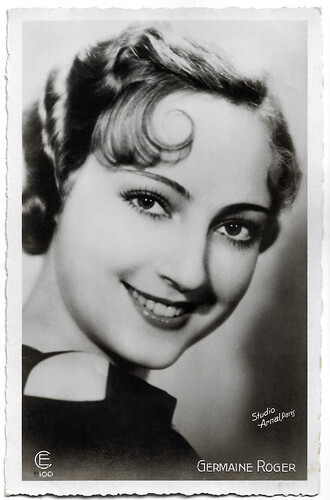
French postcard by Editions et Publications Cinématographiques (CE), no. 100. Photo: Studio Arnal, Paris.
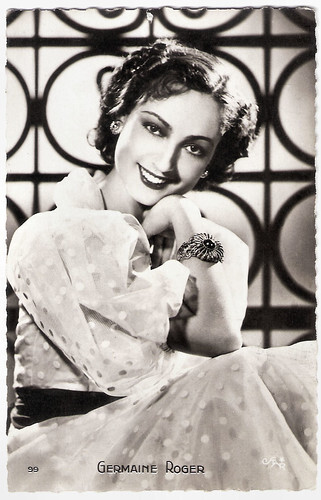
French postcard by Editions P.I., Paris, no. 99. Photo: Star*.
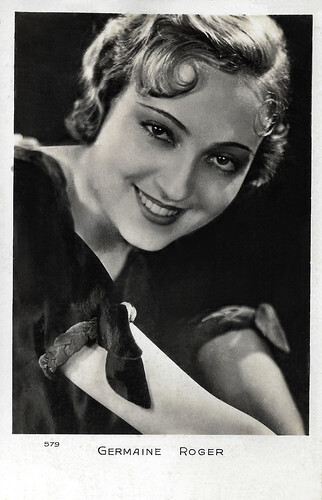
French postcard, no. 579.
The star of Vincent Scotto's film operettas
Germaine Roger was born Victoria Calixte Bousquet in 1910 in Marseille, France.
After winning a beauty contest in her home town in 1929, she was accepted as a light soprano at the Marseille Conservatoire. She made her Paris debut at the Gaîté-Lyrique.
She divided her time between the repertoire plays such as 'Mam'zelle Nitouche' and creations by Albert Willemetz, Josef Szulc, Georges van Parys, Louis Beydts and Maurice Yvain.
She also embarked on a film career. In 1932 she made her film debut in the musical comedy Coups de roulis/Tossing Ship (Jean de La Cour, 1932) starring Max Dearly . Another success was La mascotte/The Mascot (Léon Mathot, 1935) in which she starred opposite Lucien Baroux.
Germaine Roger was the star of the film adaptations of French composer Vincent Scotto's operettas such as Trois de la marine/Three Sailors (Charles Barrois, 1934) with Armand Bernard , Un de la Canebière (René Pujol, 1938), in which she performed 'Le Plus Beau Tango du monde', in a duet with Alibert , and Les Gangsters du Château d'If (René Pujol, 1939). Then, her film career halted.
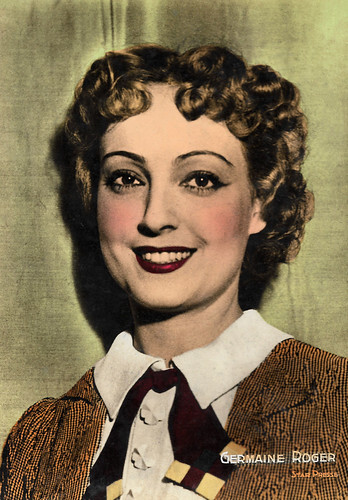
French autograph card by Star Presse. The autograph is on the flip side.
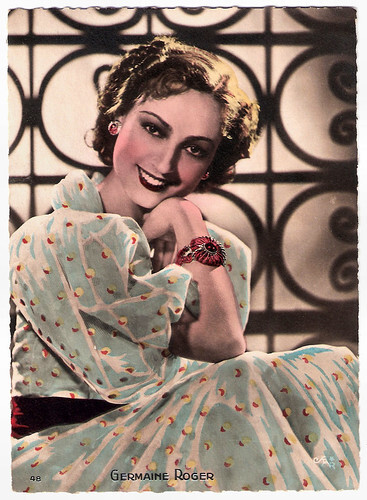
French postcard by Editions P.I., Paris, no. 48. Photo: Star*.
The Parisian temple of Operetta
After the death of her husband Henri Montjoye in 1950, Germaine Roger succeeded him as director of the Gaîté-Lyrique, the Parisian temple of Operetta.
In the early 1920s, Sergei Diaghilev's Ballets Russes danced here, and after World War II it was used for musical comedy. In the 1960s, attendance decreased, and Roger was forced to close in 1964 for financial reasons.
There were several attempts to find new uses for the building, culminating in 1989 in the construction of a short-lived amusement park, which resulted in the demolition of most of the theatre, except for the facade, entrance and foyer.
The latter was restored during a 2004 reconstruction that converted the building into an arts centre, La Gaîté Lyrique, completed in November 2010.
Germaine Roger died in 1975 in Savigny-sur-Orge.
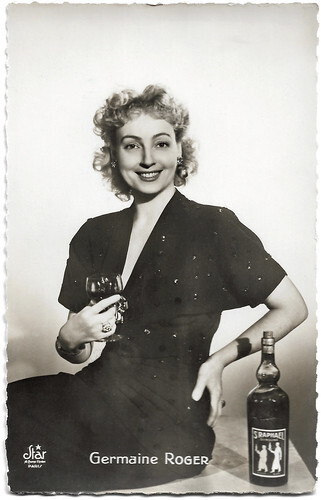
French postcard by Editions P.I., La Garenne-Colombes, for S. Raphael. Photo: *Star.
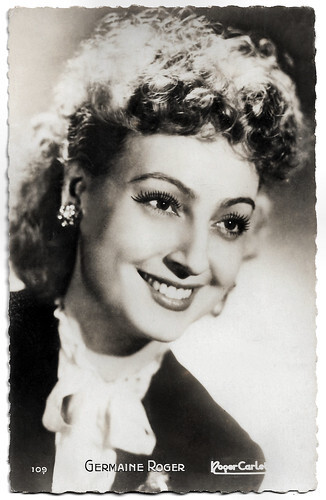
French postcard by Editions P.I., Paris, no. 109. Photo: Roger Carlet.
Sources: Wikipedia (French and English) and .

French postcard by Editions et Publications Cinématographiques (CE), no. 100. Photo: Studio Arnal, Paris.

French postcard by Editions P.I., Paris, no. 99. Photo: Star*.

French postcard, no. 579.
The star of Vincent Scotto's film operettas
Germaine Roger was born Victoria Calixte Bousquet in 1910 in Marseille, France.
After winning a beauty contest in her home town in 1929, she was accepted as a light soprano at the Marseille Conservatoire. She made her Paris debut at the Gaîté-Lyrique.
She divided her time between the repertoire plays such as 'Mam'zelle Nitouche' and creations by Albert Willemetz, Josef Szulc, Georges van Parys, Louis Beydts and Maurice Yvain.
She also embarked on a film career. In 1932 she made her film debut in the musical comedy Coups de roulis/Tossing Ship (Jean de La Cour, 1932) starring Max Dearly . Another success was La mascotte/The Mascot (Léon Mathot, 1935) in which she starred opposite Lucien Baroux.
Germaine Roger was the star of the film adaptations of French composer Vincent Scotto's operettas such as Trois de la marine/Three Sailors (Charles Barrois, 1934) with Armand Bernard , Un de la Canebière (René Pujol, 1938), in which she performed 'Le Plus Beau Tango du monde', in a duet with Alibert , and Les Gangsters du Château d'If (René Pujol, 1939). Then, her film career halted.

French autograph card by Star Presse. The autograph is on the flip side.

French postcard by Editions P.I., Paris, no. 48. Photo: Star*.
The Parisian temple of Operetta
After the death of her husband Henri Montjoye in 1950, Germaine Roger succeeded him as director of the Gaîté-Lyrique, the Parisian temple of Operetta.
In the early 1920s, Sergei Diaghilev's Ballets Russes danced here, and after World War II it was used for musical comedy. In the 1960s, attendance decreased, and Roger was forced to close in 1964 for financial reasons.
There were several attempts to find new uses for the building, culminating in 1989 in the construction of a short-lived amusement park, which resulted in the demolition of most of the theatre, except for the facade, entrance and foyer.
The latter was restored during a 2004 reconstruction that converted the building into an arts centre, La Gaîté Lyrique, completed in November 2010.
Germaine Roger died in 1975 in Savigny-sur-Orge.

French postcard by Editions P.I., La Garenne-Colombes, for S. Raphael. Photo: *Star.

French postcard by Editions P.I., Paris, no. 109. Photo: Roger Carlet.
Sources: Wikipedia (French and English) and .
Published on December 02, 2023 22:00
December 1, 2023
Directed by Augusto Genina
Augusto Genina (1892-1957) was a prolific Italian filmmaker, who was not only a director but also a producer. He was an active filmmaker for over forty years, both in silent and sound films. From the early 1910s, he realised various films with silent film divas like Helena Makowska, Italia Almirante Manzini, and Maria Jacobini, partly for his own company Genina Films. At the collapse of Italian silent film production in the early 1920s, he went abroad and directed films in Germany and France, in particular with his girlfriend and muse Carmen Boni. In the mid-1930s he returned to Italy, where he did several colonial and war propaganda films before and during the war. After the war, he made films such as Cielo sulla palude/Maria Goretti (1949) and L'edera/Devotion (1950).
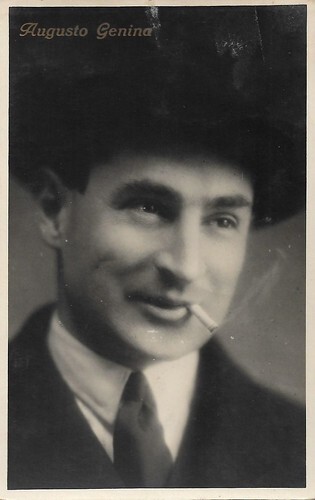
Italian postcard by G.B. Falci, Editore, Milano, no. 689. Augusto Genina.
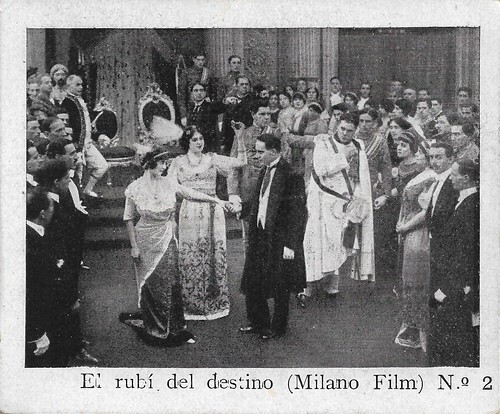
Spanish minicard by Chocolate Amatller, Barcelona, no. 2 of 6.Photo: Milano Films, Mercedes Brignone and Livio Pavanelli in Il rubino del destino/The Ruby of Destiny (Henri Étiévant, 1914), scripted by Augusto Genina. The film was released in Spain as 'El rubí del destino; in January 1914.
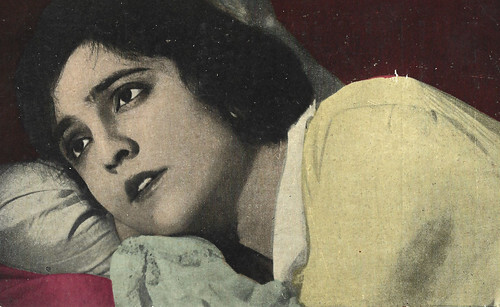
Spanish minicard by Chocolate Imperiale, card 6 of 6. Photo: Distr. J. Verdaguer, Barcelona / Itala Film. Maria Jacobini in Addio giovinezza!/Goodbye Youth (Augusto Genina, 1918). The Spanish release title was Adios, juventud!.
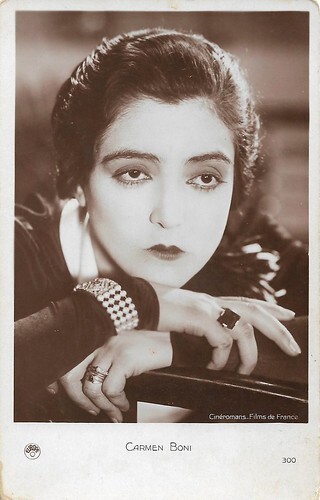
Italian postcard by Europe, no. 300. Photo: Cinéromans - Films de France. Carmen Boni probably in Totte et sa chance/La storia di una piccola Parigina (Augusto Genina, 1928), co-produced by Société des Cinéromans.
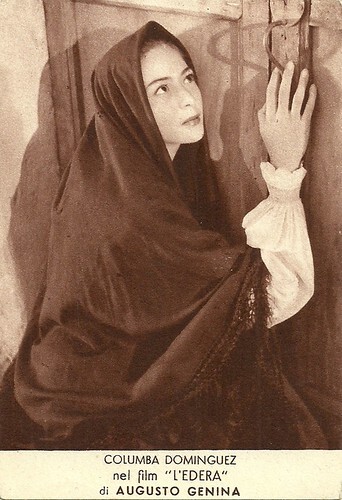
Italian postcard by Ed. Mondadori. Photo: Prod. Cines. Dist. ENIC. AGAR. Columba Dominguez in the Italian film L'edera/Devotion (Augusto Genina, 1950).
Genina's new muse and girlfriend
Augusto Genina was born in 1892 into an upper-class Roman family. His parents were Luigi Genina and Anna Tombini. After secondary school, he attended the Faculty of Engineering at the University of Rome, but never completed his studies as he soon became interested in theatre. From 1911, Genina was a playwright and drama critic for the magazine Il Mondo. On Aldo De Benedetti's advice, Genina switched to cinema as a scriptwriter for the Film d'Arte Italiana company, for which he edited the film adaptation of Beatrice d'Este (1912), starring Francesca Bertini . He later moved to Celio Film and then to Cines.
At Cines he began as assistant to director Giulio Antamoro. In 1913 he made his first film as director, La moglie di sua eccellenza/His Excellency's Wife (Augusto Genina, 1913), shot in Barcelona and produced by Film de Arte Español, the Spanish branch of Cines. A prolific director, he shot numerous films of different genres, many of them clearly derived from the theatre and centred on bourgeois marital dramas. During the First World War, Genina was released from service due to a permanent tendon injury suffered in his teens, which allowed him to continue filming regularly. In 1914 he worked for Milano Films and in 1915 for Medusa and Monopol, in 1917 for Ambrosio and Tiber, in 1918 for Itala and in 1920 for Photodrama in Turin.
Thus he directed female stars such as Maria Jacobini and Helena Makowska in Addio giovinezza!/Goodbye Youth (1918), a popular film he would remake in 1927 with Carmen Boni . With Jacobini he would also do L'onestà del peccato (1918). Other stars he worked with in the 1910s were Hesperia in Dopo il veglione (1914), Pina Menichelli in Lulù (1914), Bianca Virginia Camagni in La gelosia (1915), Mercedes Brignone in Mezzanotte (1915), Suzanne Armelle in La signorina Ciclone (1916), Yvonne De Fleuriel in Il trono e la seggiola (1918), Italia Almirante Manzini in Femmina (1918) and La maschera e il volto (1919), Diana Karenne in Lucrezia Borgia (1919), and Edy Darclea in Debito d'odio (1920).
Worthy of mention is the film Lo scaldino (Augusto Genina, 1920), starring Kally Sambuccini and Alfonso Cassini, and based on the novel of the same name by Luigi Pirandello, whose influence on Genina's work will also be seen in the later Prix de beauté/Miss Europa (Augusto Genina, 1930) starring Louise Brooks . In 1921 he founded Films Genina and in 1923 wrote the screenplay for Jolly, clown da circo, his cousin Mario Camerini's directorial debut. In the early 1920s, he also did films with Vera Vergani , Ria Bruna, and Soava Gallone , as well as adventure films such as Il corsaro (Augusto Genina, 1923) with Amleto Novelli . Despite the collapse of Italian film production, Genina still managed to continue making films, even if quite limited. In 1923 he directed the Franco-Italian prestigious early colour production Cirano di Bergerac/Cyrano de Bergerac, starring Pierre Magnier , Linda Moglia and Angelo Ferrari .
During the production of La moglie bella (1924), starring Linda Moglia , Genina discovered supporting actress Carmelita Bonicatti, better known as Carmen Boni . Boni became Genina's new muse and girlfriend, and eventually, in 1924, his wife. While Boni first starred in three Italian films by Genina: Il focolare spento (1925), L'ultimo Lord (1926) and Addio giovinezza! (1927), together they went to Berlin, where Boni starred in Genina's films Die Gefangene von Shanghai (1927), Scampolo (1928), with exteriors in Italy, Liebeskarneval (1928), Quartier Latin (1929), with exteriors in Paris, as well as the Franco-German coproduction Totte et sa chance/Der Sprung ins Glück/Die Geschichte einer kleinen Pariserin (1929). Eventually, Boni and Genina divorced, and both would remarry with others.
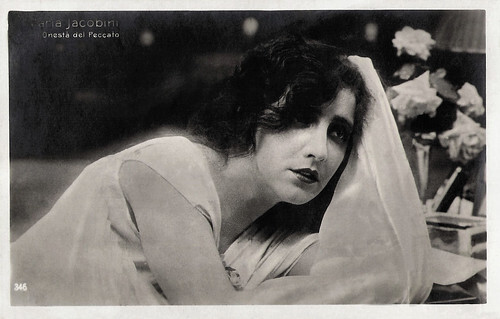
Italian postcard by Ed. Vettori, Bologna, no. 346. Sent by mail in 1926. Maria Jacobini in L'onestà del Peccato/The Wife He Neglected (Augusto Genina, 1918).
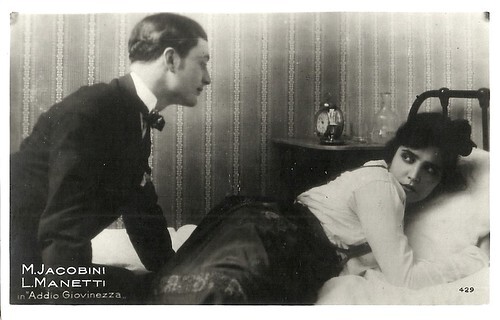
Italian postcard by Ed. Vettori, Bologna, no. 429. Maria Jacobini and Lido Manetti in Addio giovinezza!/Goodbye Youth (Augusto Genina, Itala Film 1918), a silent film adaptation of the play by Sandro Camasio and Nino Oxilia.
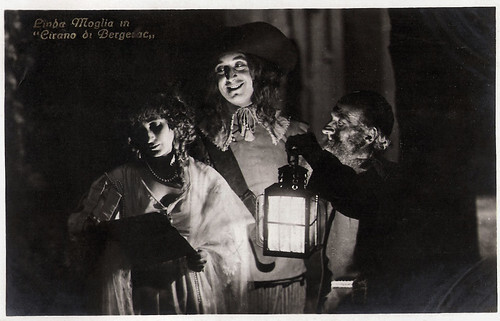
Italian postcard by G.B. Falci, Milano, no. 226. Photo: UCI. Pierre Magnier as Cyrano de Bergerac and Linda Moglia as Roxane in Cirano di Bergerac (Augusto Genina, 1923), based on Edmond Rostand's famous play Cyrano de Bergerac.
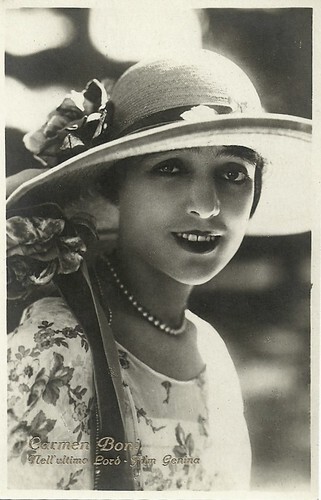
Italian postcard by Ed. G.B. Falci, no. 480. Photo: Film Genina. Carmen Boni in L'ultimo Lord (Augusto Genina, 1926).
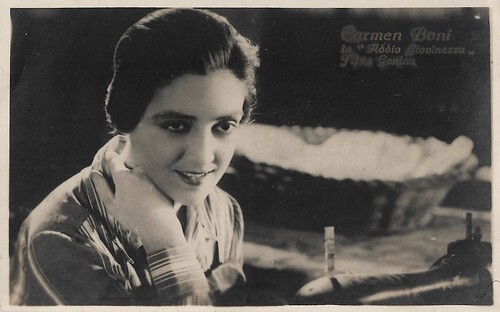
Italian postcard by Ed. G.B. Falci, Milano, no. 698. Photo: Films Genina. Carmen Boni in Addio giovinezza/Goodbye Youth (Augusto Genina, 1927).
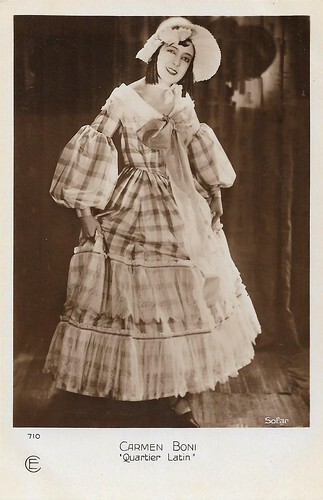
French postcard. by Cinémagazine-Edition, no. 710. Photo: Sofar. Carmen Boni in Quartier Latin/Latin Quarter (Augusto Genina, 1929). Orplid-Film produced the film, Messtro-Film distributed it in Germany.
One of Fascism's leading filmmakers
In 1929 Augusto Genina directed Louise Brooks in the highly successful Prix de beauté (1930), a film shot in silent and later soundtracked version, scripted by René Clair and Georg Wilhelm Pabst. In 1931 he directed both the German and the French versions of Mitternachtsliebe/Les amours de minuit, co-directed respectively with Carl Froehlich and Marc Allégret, and starring Danièle Parola in both versions. Memorable is also Paris-Beguin (1931) with Jean Gabin and Jane Marnac, while Boni and Genina did two last films together in France: the comedies La femme en homme (1932) and Ne sois pas jalouse (1934). In 1934 Boni and Genina divorced. In 1939 he married the British Elisabeth 'Betty' Becker.
In the mid-1930s Genina changed employers, starting with a series of Italo-German coproductions with opera stars such as Beniamino Gigli and Erna Sack. After almost a decade abroad, Genina made a definitive return to Italy in the late 1930s. In 1936, he directed the war film Lo squadrone biancoThe White Squadron (Augusto Genina, 1936) in the Libyan desert, which won the Mussolini Cup for Best Italian Film at the Venice Film Festival.
He became one of Fascism's leading filmmakers, making L'assedio dell'Alcazar (1939), another propaganda war film illustrating an episode from the Spanish Civil War, and Bengasi (1942), a film about the British attack on the Italians in the Libyan city during World War II. He alternated these with lighter fare such as Naples au baiser du feu/The Kiss of Fire (1937), a film that secured singer Tino Rossi a big success, and Castelli in aria (1939), a comedy with Lilian Harvey and Vittorio De Sica . Yet, in 1942 Genina stopped directing after Bengasi and it would take at least eight years before he started again directing.
In the post-war period, Genina attempted an approach to neorealism with Cielo sulla palude/Maria Goretti (1949), a biographical work about Maria Goretti, filmed in a wonderful Caravaggesque style by Aldo Graziati , but critics found his melodramatic realism too mannered at the time. In 1950 Genina directed L'edera, based on the novel of the same name by Grazia Deledda. In Tre storie proibite (1953), Genina filmed the story of the collapse of a staircase that swept away a large number of young girls who had rushed to find a job as typists, already the subject of Giuseppe De Santis's film Roma ore 11. In 1953 Genina also directed the film Maddalena, set in the Sannio region in the characteristic villages of Guardia Sanframondi and Cerreto Sannita. The film starred Gino Cervi and Swedish actress Märta Torén .
In 1955 Genina shot his last film, Frou Frou (1955), after which he retired due to endocarditis from which he had suffered for a long time. Augusto Genina died in 1957. All in all, he directed almost 100 films, wrote almost 50 scripts and produced 2 films.
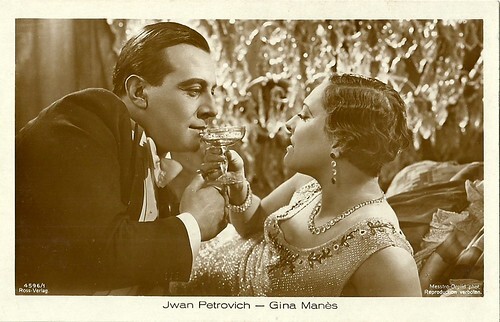
German postcard by Ross Verlag, no. 4596/1, 1929-1930. Photo Messtro-Orplid. Ivan Petrovich and Gina Manès in Quartier Latin (Augusto Genina, 1929).
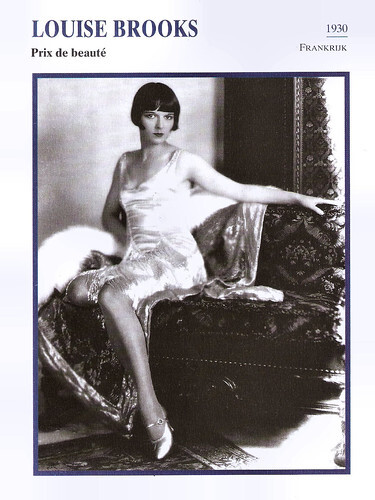
Dutch collectors card in the series 'Filmsterren: een portret' by Edito Service, 1995. Photo: Stars-Films. Louise Brooks in Prix de Beauté (Augusto Genina, 1930).
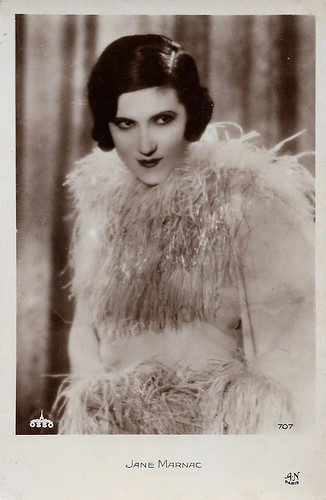
French postcard by A.N., Paris, no. 707. Photo: Les Films Osso. Jane Marnac in Paris-Béguin (Augusto Genina, 1931).
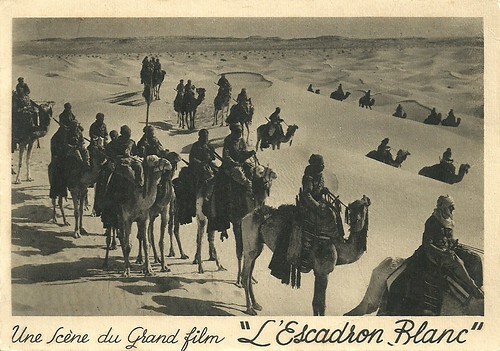
French postcard by Radiogravure A. Breger Frères, Arcueil. Photo: publicity still for the Italian colonial film Lo squadrone bianco/White Squadron (Augusto Genina, 1936), starring Antonio Centa and Fosco Giachetti . The film focuses on Italian troops in Africa and was based on a French novel by Joseph Peyré, 'L'escadron blanc', but in adapting the original French novel for an Italian film, the French soldiers in Algeria were changed to Italian soldiers in Libya.
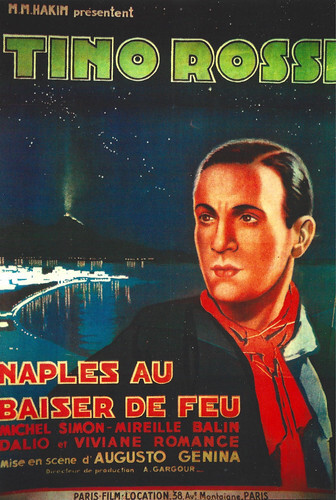
French postcard by Encyclopédie du cinéma, Carte artistique et cinématographique. Reproduction of French film poster for the film Naples au baiser de feu/The Kiss of Fire (Augusto Genina, 1937), starring Tino Rossi .
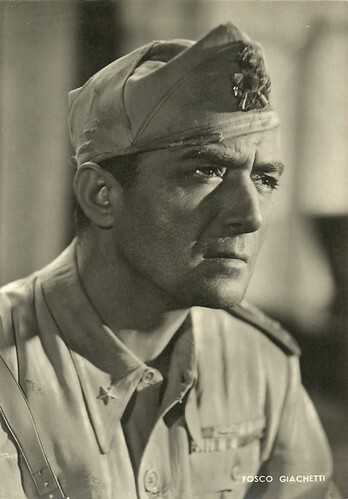
Italian postcard by ASER. Photo: Bassoli, Tirrenia. Fosco Giachetti in Bengasi (Augusto Genina, 1942).
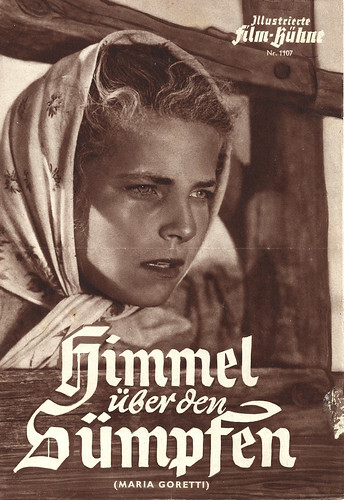
German film brochure by Illustrerte Film-Bühne, no. 107. Film special on the Italian film Cielo sulla palude/Heaven over the Marshes (Augusto Genina, 1949), a historical drama on the life of little (afterwards Saint) Maria Goretti, played by Ines Orsini, and filmed with Caravaggesque cinematography by Aldo Graziati (G.R. Aldo').
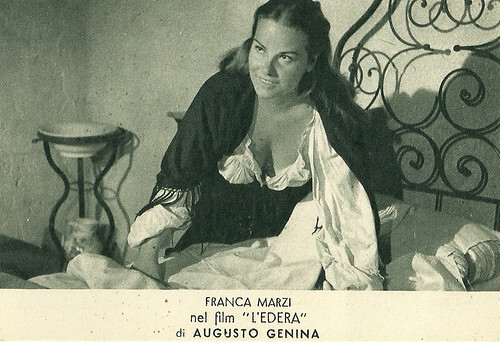
Italian postcard by Ed. Mondadori. Photo: Prod. Cines. / Dist. ENIC / AGAR. Franca Marzi as Zana in L'edera/Delitto per amore/Devotion (Augusto Genina 1950).
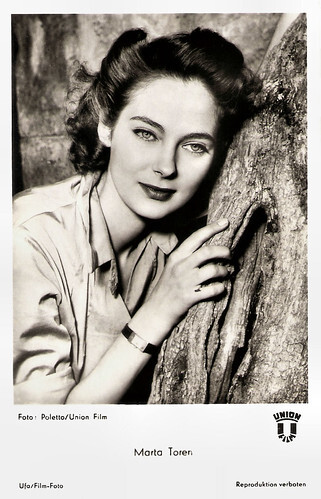
German postcard by Ufa, Berlin-Tempelhof, no FK 1079. Photo: Poletto / Union-Film. Marta Toren in Maddalena (Augusto Gennina, 1954).
Sources: Wikipedia (Italian) and .

Italian postcard by G.B. Falci, Editore, Milano, no. 689. Augusto Genina.

Spanish minicard by Chocolate Amatller, Barcelona, no. 2 of 6.Photo: Milano Films, Mercedes Brignone and Livio Pavanelli in Il rubino del destino/The Ruby of Destiny (Henri Étiévant, 1914), scripted by Augusto Genina. The film was released in Spain as 'El rubí del destino; in January 1914.

Spanish minicard by Chocolate Imperiale, card 6 of 6. Photo: Distr. J. Verdaguer, Barcelona / Itala Film. Maria Jacobini in Addio giovinezza!/Goodbye Youth (Augusto Genina, 1918). The Spanish release title was Adios, juventud!.

Italian postcard by Europe, no. 300. Photo: Cinéromans - Films de France. Carmen Boni probably in Totte et sa chance/La storia di una piccola Parigina (Augusto Genina, 1928), co-produced by Société des Cinéromans.

Italian postcard by Ed. Mondadori. Photo: Prod. Cines. Dist. ENIC. AGAR. Columba Dominguez in the Italian film L'edera/Devotion (Augusto Genina, 1950).
Genina's new muse and girlfriend
Augusto Genina was born in 1892 into an upper-class Roman family. His parents were Luigi Genina and Anna Tombini. After secondary school, he attended the Faculty of Engineering at the University of Rome, but never completed his studies as he soon became interested in theatre. From 1911, Genina was a playwright and drama critic for the magazine Il Mondo. On Aldo De Benedetti's advice, Genina switched to cinema as a scriptwriter for the Film d'Arte Italiana company, for which he edited the film adaptation of Beatrice d'Este (1912), starring Francesca Bertini . He later moved to Celio Film and then to Cines.
At Cines he began as assistant to director Giulio Antamoro. In 1913 he made his first film as director, La moglie di sua eccellenza/His Excellency's Wife (Augusto Genina, 1913), shot in Barcelona and produced by Film de Arte Español, the Spanish branch of Cines. A prolific director, he shot numerous films of different genres, many of them clearly derived from the theatre and centred on bourgeois marital dramas. During the First World War, Genina was released from service due to a permanent tendon injury suffered in his teens, which allowed him to continue filming regularly. In 1914 he worked for Milano Films and in 1915 for Medusa and Monopol, in 1917 for Ambrosio and Tiber, in 1918 for Itala and in 1920 for Photodrama in Turin.
Thus he directed female stars such as Maria Jacobini and Helena Makowska in Addio giovinezza!/Goodbye Youth (1918), a popular film he would remake in 1927 with Carmen Boni . With Jacobini he would also do L'onestà del peccato (1918). Other stars he worked with in the 1910s were Hesperia in Dopo il veglione (1914), Pina Menichelli in Lulù (1914), Bianca Virginia Camagni in La gelosia (1915), Mercedes Brignone in Mezzanotte (1915), Suzanne Armelle in La signorina Ciclone (1916), Yvonne De Fleuriel in Il trono e la seggiola (1918), Italia Almirante Manzini in Femmina (1918) and La maschera e il volto (1919), Diana Karenne in Lucrezia Borgia (1919), and Edy Darclea in Debito d'odio (1920).
Worthy of mention is the film Lo scaldino (Augusto Genina, 1920), starring Kally Sambuccini and Alfonso Cassini, and based on the novel of the same name by Luigi Pirandello, whose influence on Genina's work will also be seen in the later Prix de beauté/Miss Europa (Augusto Genina, 1930) starring Louise Brooks . In 1921 he founded Films Genina and in 1923 wrote the screenplay for Jolly, clown da circo, his cousin Mario Camerini's directorial debut. In the early 1920s, he also did films with Vera Vergani , Ria Bruna, and Soava Gallone , as well as adventure films such as Il corsaro (Augusto Genina, 1923) with Amleto Novelli . Despite the collapse of Italian film production, Genina still managed to continue making films, even if quite limited. In 1923 he directed the Franco-Italian prestigious early colour production Cirano di Bergerac/Cyrano de Bergerac, starring Pierre Magnier , Linda Moglia and Angelo Ferrari .
During the production of La moglie bella (1924), starring Linda Moglia , Genina discovered supporting actress Carmelita Bonicatti, better known as Carmen Boni . Boni became Genina's new muse and girlfriend, and eventually, in 1924, his wife. While Boni first starred in three Italian films by Genina: Il focolare spento (1925), L'ultimo Lord (1926) and Addio giovinezza! (1927), together they went to Berlin, where Boni starred in Genina's films Die Gefangene von Shanghai (1927), Scampolo (1928), with exteriors in Italy, Liebeskarneval (1928), Quartier Latin (1929), with exteriors in Paris, as well as the Franco-German coproduction Totte et sa chance/Der Sprung ins Glück/Die Geschichte einer kleinen Pariserin (1929). Eventually, Boni and Genina divorced, and both would remarry with others.

Italian postcard by Ed. Vettori, Bologna, no. 346. Sent by mail in 1926. Maria Jacobini in L'onestà del Peccato/The Wife He Neglected (Augusto Genina, 1918).

Italian postcard by Ed. Vettori, Bologna, no. 429. Maria Jacobini and Lido Manetti in Addio giovinezza!/Goodbye Youth (Augusto Genina, Itala Film 1918), a silent film adaptation of the play by Sandro Camasio and Nino Oxilia.

Italian postcard by G.B. Falci, Milano, no. 226. Photo: UCI. Pierre Magnier as Cyrano de Bergerac and Linda Moglia as Roxane in Cirano di Bergerac (Augusto Genina, 1923), based on Edmond Rostand's famous play Cyrano de Bergerac.

Italian postcard by Ed. G.B. Falci, no. 480. Photo: Film Genina. Carmen Boni in L'ultimo Lord (Augusto Genina, 1926).

Italian postcard by Ed. G.B. Falci, Milano, no. 698. Photo: Films Genina. Carmen Boni in Addio giovinezza/Goodbye Youth (Augusto Genina, 1927).

French postcard. by Cinémagazine-Edition, no. 710. Photo: Sofar. Carmen Boni in Quartier Latin/Latin Quarter (Augusto Genina, 1929). Orplid-Film produced the film, Messtro-Film distributed it in Germany.
One of Fascism's leading filmmakers
In 1929 Augusto Genina directed Louise Brooks in the highly successful Prix de beauté (1930), a film shot in silent and later soundtracked version, scripted by René Clair and Georg Wilhelm Pabst. In 1931 he directed both the German and the French versions of Mitternachtsliebe/Les amours de minuit, co-directed respectively with Carl Froehlich and Marc Allégret, and starring Danièle Parola in both versions. Memorable is also Paris-Beguin (1931) with Jean Gabin and Jane Marnac, while Boni and Genina did two last films together in France: the comedies La femme en homme (1932) and Ne sois pas jalouse (1934). In 1934 Boni and Genina divorced. In 1939 he married the British Elisabeth 'Betty' Becker.
In the mid-1930s Genina changed employers, starting with a series of Italo-German coproductions with opera stars such as Beniamino Gigli and Erna Sack. After almost a decade abroad, Genina made a definitive return to Italy in the late 1930s. In 1936, he directed the war film Lo squadrone biancoThe White Squadron (Augusto Genina, 1936) in the Libyan desert, which won the Mussolini Cup for Best Italian Film at the Venice Film Festival.
He became one of Fascism's leading filmmakers, making L'assedio dell'Alcazar (1939), another propaganda war film illustrating an episode from the Spanish Civil War, and Bengasi (1942), a film about the British attack on the Italians in the Libyan city during World War II. He alternated these with lighter fare such as Naples au baiser du feu/The Kiss of Fire (1937), a film that secured singer Tino Rossi a big success, and Castelli in aria (1939), a comedy with Lilian Harvey and Vittorio De Sica . Yet, in 1942 Genina stopped directing after Bengasi and it would take at least eight years before he started again directing.
In the post-war period, Genina attempted an approach to neorealism with Cielo sulla palude/Maria Goretti (1949), a biographical work about Maria Goretti, filmed in a wonderful Caravaggesque style by Aldo Graziati , but critics found his melodramatic realism too mannered at the time. In 1950 Genina directed L'edera, based on the novel of the same name by Grazia Deledda. In Tre storie proibite (1953), Genina filmed the story of the collapse of a staircase that swept away a large number of young girls who had rushed to find a job as typists, already the subject of Giuseppe De Santis's film Roma ore 11. In 1953 Genina also directed the film Maddalena, set in the Sannio region in the characteristic villages of Guardia Sanframondi and Cerreto Sannita. The film starred Gino Cervi and Swedish actress Märta Torén .
In 1955 Genina shot his last film, Frou Frou (1955), after which he retired due to endocarditis from which he had suffered for a long time. Augusto Genina died in 1957. All in all, he directed almost 100 films, wrote almost 50 scripts and produced 2 films.

German postcard by Ross Verlag, no. 4596/1, 1929-1930. Photo Messtro-Orplid. Ivan Petrovich and Gina Manès in Quartier Latin (Augusto Genina, 1929).

Dutch collectors card in the series 'Filmsterren: een portret' by Edito Service, 1995. Photo: Stars-Films. Louise Brooks in Prix de Beauté (Augusto Genina, 1930).

French postcard by A.N., Paris, no. 707. Photo: Les Films Osso. Jane Marnac in Paris-Béguin (Augusto Genina, 1931).

French postcard by Radiogravure A. Breger Frères, Arcueil. Photo: publicity still for the Italian colonial film Lo squadrone bianco/White Squadron (Augusto Genina, 1936), starring Antonio Centa and Fosco Giachetti . The film focuses on Italian troops in Africa and was based on a French novel by Joseph Peyré, 'L'escadron blanc', but in adapting the original French novel for an Italian film, the French soldiers in Algeria were changed to Italian soldiers in Libya.

French postcard by Encyclopédie du cinéma, Carte artistique et cinématographique. Reproduction of French film poster for the film Naples au baiser de feu/The Kiss of Fire (Augusto Genina, 1937), starring Tino Rossi .

Italian postcard by ASER. Photo: Bassoli, Tirrenia. Fosco Giachetti in Bengasi (Augusto Genina, 1942).

German film brochure by Illustrerte Film-Bühne, no. 107. Film special on the Italian film Cielo sulla palude/Heaven over the Marshes (Augusto Genina, 1949), a historical drama on the life of little (afterwards Saint) Maria Goretti, played by Ines Orsini, and filmed with Caravaggesque cinematography by Aldo Graziati (G.R. Aldo').

Italian postcard by Ed. Mondadori. Photo: Prod. Cines. / Dist. ENIC / AGAR. Franca Marzi as Zana in L'edera/Delitto per amore/Devotion (Augusto Genina 1950).

German postcard by Ufa, Berlin-Tempelhof, no FK 1079. Photo: Poletto / Union-Film. Marta Toren in Maddalena (Augusto Gennina, 1954).
Sources: Wikipedia (Italian) and .
Published on December 01, 2023 22:00
November 30, 2023
Davey Lee
Davey Lee (1924-2008) was the child star who was billed with Al Jolson in the box office hit The Singing Fool (1928), Jolson's second talking film. He appeared in six feature films between 1928 and 1930. "Sonny Boy"'s film career ended at the age of six.
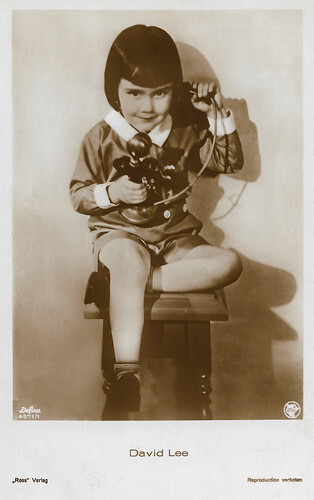
German postcard by Ross Verlag, no. 4571/1, 1930-1931. Photo: First National / Defina.
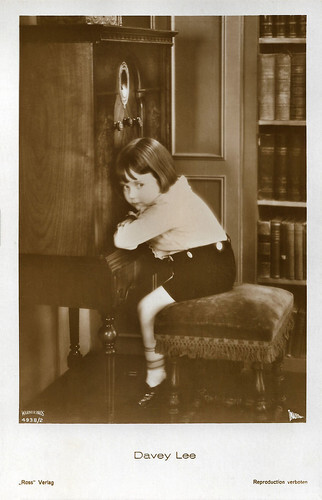
German postcard by Ross Verlag, no. 4938/2, 1930-1931. Photo: Warner Bros. / National.
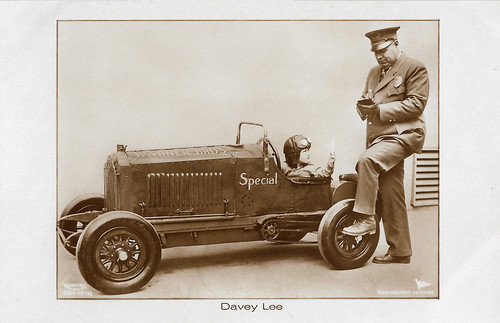
German postcard by Ross Verlag, no. 5184/1, 1930-1931. Photo: Warner Bros. / National. Collection: Geoffrey Donaldson Institute.
Sonny Boy
Davey Lee was born David Lea in Hollywood, California, in 1924. He followed his brother, Frankie Lee, who was three years older, into show business.
Soon he became a far greater star. He was cast as Al Jolson 's three-year-old son in one of the early talkies, The Singing Fool (Lloyd Bacon, 1928). Davey was dubbed "Sonny Boy", an appellation that remained with him for the rest of his life.
The song 'Sonny Boy' was a solid hit, credited by Wikipedia as being the first million-selling recording. The film, The Singing Fool, was Warner Bros.'s most successful film for more than ten years and remained the top-grossing film until Gone With The Wind (Victor Fleming, 1939).
Young Davey Lee became quite a Hollywood phenomenon. He was quickly featured in a film of his own, Sonny Boy (Archie Mayo, 1929), with Edward Everett Horton and Betty Bronson . A part of the film was shot silent, and other scenes were filmed in the Vitaphone sound-on-disc system.
The film has a decidedly adult major theme of infidelity and divorce. The climax of the film, which unfortunately is considered lost, featured Davey Lee, himself, singing a full-throated version of 'Sonny Boy'. The film was another box office hit.
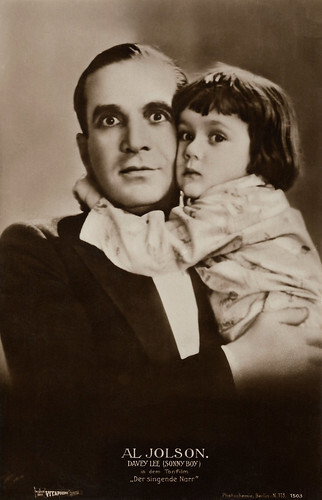
German postcard by Photochemie, Berlin, no. 1503. Photo: Warner Bros Vitaphone. Al Jolson and Davey Lee in The Singing Fool (Lloyd Bacon, 1928).
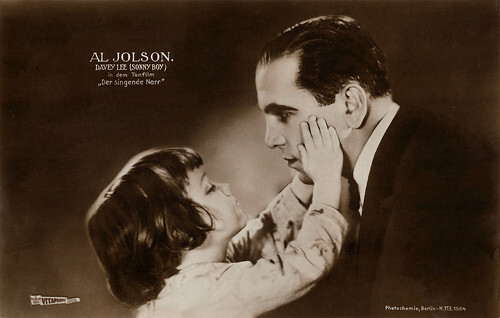
German postcard by Photochemie, Berlin, no. 1504. Photo: Warner Bros Vitaphone. Al Jolson and Davey Lee in The Singing Fool (Lloyd Bacon, 1928).
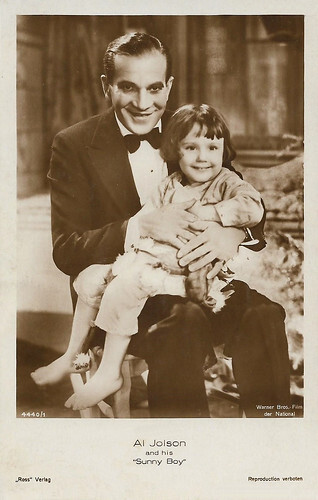
German postcard by Ross Verlag, no. 4440/1, 1929-1930. Photo: Warner Bros. Film / National. Al Jolson and his 'Sunny Boy' (Davey Lee) in the early sound film The Singing Fool (Lloyd Bacon, 1928).
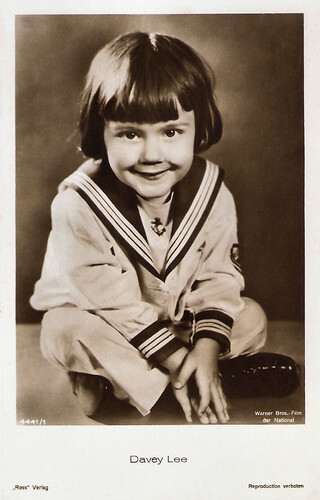
German postcard by Ross Verlag, no. 4441/1, 1930-1931. Photo: Warner Bros.
Little Pal
Davey Lee's next film was another first, the debut of canine star Rin Tin Tin in Frozen River (F. Harmon Weight, 1929), a part-talkie with sound recorded in the Vitaphone process, which is also considered lost.
During the filming, Rin Tin Tin reportedly did not recognise Davey as the star that he was, and tried to take a nip out of the child. Still, Davey was rescued in the scene.
Davey returned to Al Jolson 's side in the sound film Say It With Songs (Lloyd Bacon, 1929). Reprising his role with a new name, "Little Pal", Davey survives in this movie, providing a happy ending for a Jolson film most notable for its lack of blackface. It was also the first Al Jolson movie considered as a flop.
However, according to Warner Bros records it still earned $1,715,000 domestically and $551,000 foreign. At about the same time, Davey entered the recording studio for the track 'Sonny Boy's Bear Story', a monologue with a song accompanied by a small orchestra. It was told in two parts, on both sides of a 78 rpm record, and, reportedly, sold quite well.
Also that year, Davey appeared in the drama Skin Deep (Ray Enright, 1929), co-starring with Monte Blue and Betty Compson .
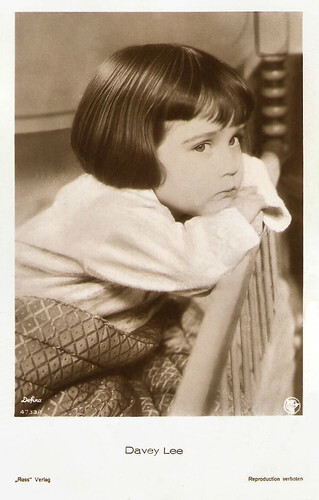
German postcard by Ross Verlag, Berlin, no. 4733/1, 1930-1931. Photo: Defina / First National.
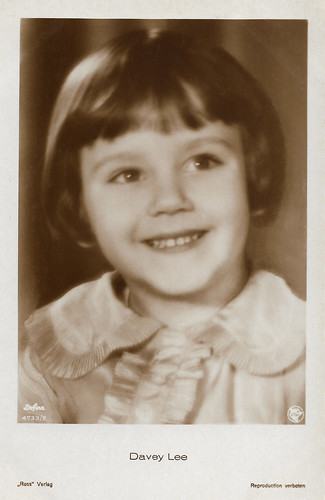
German postcard by Ross Verlag, Berlin, no. 4733/2, 1929-1930. Photo: Defina / First National. Collection: Geoffrey Donaldson Institute.
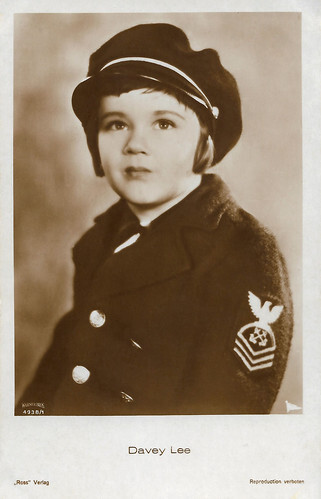
German postcard by Ross Verlag, Berlin, no. 4938/1, 1930-1931. Photo: Warner Bros. / National.
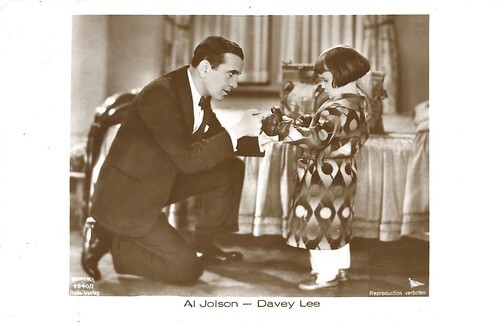
German postcard by Ross Verlag, Berlin, no. 4940/2. Photo: Warner Bros. / National. Al Jolson and Davey Lee in Say It With Songs (Lloyd Bacon, 1929).
Son of a gang czar
In 1930, Davey Lee played in The Squealer (Harry Joe Brown, 1930), the story of a gang czar and his society wife starring Jack Holt , Dorothy Revier and Zasu Pitts. Davey played Jack Holt's son.
Davey also recorded another record that year, 'I've Lost My Dog' and 'Davey and His Tog Tatters', released on the Brunswick label. Unfortunately, no copies of this recording are known to exist.
Reportedly earning some $3000 per week in 1930, Davey Lee left show business at the ripe age of six. Davey was taken out of films by his mother reportedly so he could have a normal childhood. There are also stories that his health was suffering, and others that his mother received an offer of $3500 for him to make appearances in vaudeville.
Anyhow, this was the end of his short film career. He served in the U.S. Army during WWII and later worked in community theatre. Despite some of Al Jolson 's stories to the contrary, there is no evidence that he and Davey ever crossed paths in later life. There is only a 1949 photo from the era of the Jolson biopics, which shows Davey Lee, then 24 years old, again sitting on Al Jolson's knee. This may have been their last meeting, as Al Jolson died the next year.
Later in life, he enjoyed performing in local theatre and was a guest at several annual conventions of the International Al Jolson Society. After suffering a stroke, Davey Lee was admitted to Windsor Gardens Healthcare Centre in Van Nuys, California, and in 2008, he died from natural causes in Los Angeles, aged 83.
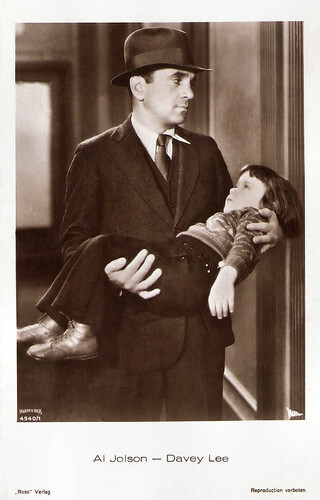
German postcard by Ross Verlag, no. 4940/1, 1929-1930. Photo: Warner Bros. / National. Al Jolson and Davey Lee in The Singing Fool (Lloyd Bacon, 1928).
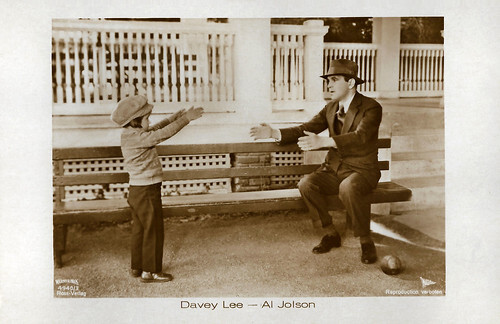
German postcard by Ross Verlag, no. 4940/3, 1930-1931. Photo: Warner Bros / National. Davey Lee and Al Jolson in Say It with Songs (Lloyd Bacon, 1929).
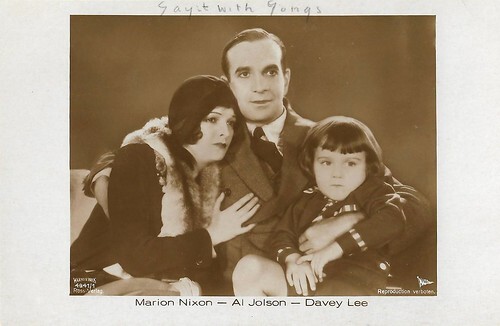
German postcard by Ross Verlag, Berlin, no. 4941/1. Photo: National / Warner Bros. Al Jolson , Marion Nixon and Davey Lee in Say It With Songs (Lloyd Bacon, 1929).
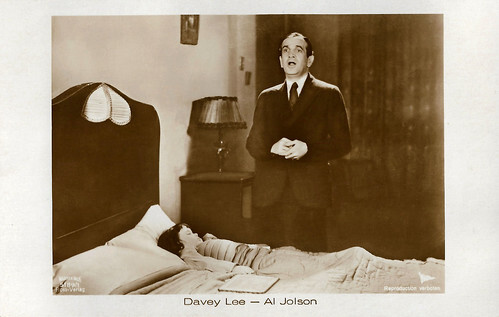
German postcard by Ross Verlag, no. 5189/1. Photo: Warner Bros. Al Jolson and Davey Lee in Say It with Songs (Lloyd Bacon, 1929). In his dreams, the boy sees and hears his father singing 'Little Pal' to him. The superimposition used in the film is absent on this card.
Sources: Al Jolson Society, Wikipedia and .

German postcard by Ross Verlag, no. 4571/1, 1930-1931. Photo: First National / Defina.

German postcard by Ross Verlag, no. 4938/2, 1930-1931. Photo: Warner Bros. / National.

German postcard by Ross Verlag, no. 5184/1, 1930-1931. Photo: Warner Bros. / National. Collection: Geoffrey Donaldson Institute.
Sonny Boy
Davey Lee was born David Lea in Hollywood, California, in 1924. He followed his brother, Frankie Lee, who was three years older, into show business.
Soon he became a far greater star. He was cast as Al Jolson 's three-year-old son in one of the early talkies, The Singing Fool (Lloyd Bacon, 1928). Davey was dubbed "Sonny Boy", an appellation that remained with him for the rest of his life.
The song 'Sonny Boy' was a solid hit, credited by Wikipedia as being the first million-selling recording. The film, The Singing Fool, was Warner Bros.'s most successful film for more than ten years and remained the top-grossing film until Gone With The Wind (Victor Fleming, 1939).
Young Davey Lee became quite a Hollywood phenomenon. He was quickly featured in a film of his own, Sonny Boy (Archie Mayo, 1929), with Edward Everett Horton and Betty Bronson . A part of the film was shot silent, and other scenes were filmed in the Vitaphone sound-on-disc system.
The film has a decidedly adult major theme of infidelity and divorce. The climax of the film, which unfortunately is considered lost, featured Davey Lee, himself, singing a full-throated version of 'Sonny Boy'. The film was another box office hit.

German postcard by Photochemie, Berlin, no. 1503. Photo: Warner Bros Vitaphone. Al Jolson and Davey Lee in The Singing Fool (Lloyd Bacon, 1928).

German postcard by Photochemie, Berlin, no. 1504. Photo: Warner Bros Vitaphone. Al Jolson and Davey Lee in The Singing Fool (Lloyd Bacon, 1928).

German postcard by Ross Verlag, no. 4440/1, 1929-1930. Photo: Warner Bros. Film / National. Al Jolson and his 'Sunny Boy' (Davey Lee) in the early sound film The Singing Fool (Lloyd Bacon, 1928).

German postcard by Ross Verlag, no. 4441/1, 1930-1931. Photo: Warner Bros.
Little Pal
Davey Lee's next film was another first, the debut of canine star Rin Tin Tin in Frozen River (F. Harmon Weight, 1929), a part-talkie with sound recorded in the Vitaphone process, which is also considered lost.
During the filming, Rin Tin Tin reportedly did not recognise Davey as the star that he was, and tried to take a nip out of the child. Still, Davey was rescued in the scene.
Davey returned to Al Jolson 's side in the sound film Say It With Songs (Lloyd Bacon, 1929). Reprising his role with a new name, "Little Pal", Davey survives in this movie, providing a happy ending for a Jolson film most notable for its lack of blackface. It was also the first Al Jolson movie considered as a flop.
However, according to Warner Bros records it still earned $1,715,000 domestically and $551,000 foreign. At about the same time, Davey entered the recording studio for the track 'Sonny Boy's Bear Story', a monologue with a song accompanied by a small orchestra. It was told in two parts, on both sides of a 78 rpm record, and, reportedly, sold quite well.
Also that year, Davey appeared in the drama Skin Deep (Ray Enright, 1929), co-starring with Monte Blue and Betty Compson .

German postcard by Ross Verlag, Berlin, no. 4733/1, 1930-1931. Photo: Defina / First National.

German postcard by Ross Verlag, Berlin, no. 4733/2, 1929-1930. Photo: Defina / First National. Collection: Geoffrey Donaldson Institute.

German postcard by Ross Verlag, Berlin, no. 4938/1, 1930-1931. Photo: Warner Bros. / National.

German postcard by Ross Verlag, Berlin, no. 4940/2. Photo: Warner Bros. / National. Al Jolson and Davey Lee in Say It With Songs (Lloyd Bacon, 1929).
Son of a gang czar
In 1930, Davey Lee played in The Squealer (Harry Joe Brown, 1930), the story of a gang czar and his society wife starring Jack Holt , Dorothy Revier and Zasu Pitts. Davey played Jack Holt's son.
Davey also recorded another record that year, 'I've Lost My Dog' and 'Davey and His Tog Tatters', released on the Brunswick label. Unfortunately, no copies of this recording are known to exist.
Reportedly earning some $3000 per week in 1930, Davey Lee left show business at the ripe age of six. Davey was taken out of films by his mother reportedly so he could have a normal childhood. There are also stories that his health was suffering, and others that his mother received an offer of $3500 for him to make appearances in vaudeville.
Anyhow, this was the end of his short film career. He served in the U.S. Army during WWII and later worked in community theatre. Despite some of Al Jolson 's stories to the contrary, there is no evidence that he and Davey ever crossed paths in later life. There is only a 1949 photo from the era of the Jolson biopics, which shows Davey Lee, then 24 years old, again sitting on Al Jolson's knee. This may have been their last meeting, as Al Jolson died the next year.
Later in life, he enjoyed performing in local theatre and was a guest at several annual conventions of the International Al Jolson Society. After suffering a stroke, Davey Lee was admitted to Windsor Gardens Healthcare Centre in Van Nuys, California, and in 2008, he died from natural causes in Los Angeles, aged 83.

German postcard by Ross Verlag, no. 4940/1, 1929-1930. Photo: Warner Bros. / National. Al Jolson and Davey Lee in The Singing Fool (Lloyd Bacon, 1928).

German postcard by Ross Verlag, no. 4940/3, 1930-1931. Photo: Warner Bros / National. Davey Lee and Al Jolson in Say It with Songs (Lloyd Bacon, 1929).

German postcard by Ross Verlag, Berlin, no. 4941/1. Photo: National / Warner Bros. Al Jolson , Marion Nixon and Davey Lee in Say It With Songs (Lloyd Bacon, 1929).

German postcard by Ross Verlag, no. 5189/1. Photo: Warner Bros. Al Jolson and Davey Lee in Say It with Songs (Lloyd Bacon, 1929). In his dreams, the boy sees and hears his father singing 'Little Pal' to him. The superimposition used in the film is absent on this card.
Sources: Al Jolson Society, Wikipedia and .
Published on November 30, 2023 22:00
November 29, 2023
La Collectionneuse: Faith Domergue
Faith Domergue was one of the many actresses who have crossed the path of eccentric Howard Hughes. She never became as successful as Jane Russell, another Hughes’ protégée, but she still made her mark in the movies and notably starred in the Science-Fiction classic This Island Earth (1955).

British postcard in the Picturegoer series, London, no. D197. Photo: R.K.O. Radio.
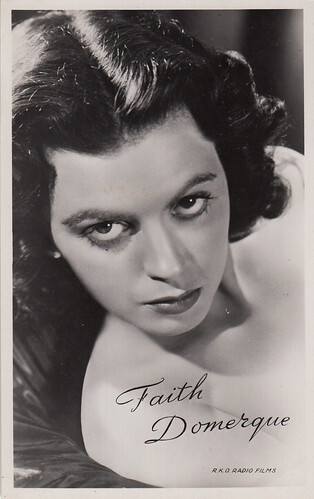
Dutch postcard by Takken, no. A.X. 1081. Photo: R.K.O. Radio Films.
Howard Hughes’ protégée
Faith Domergue was born on the 16th of June 1924 or 1925 in New Orleans, Louisiana, U.S.A. When she was six weeks old, she was adopted by Adabelle Wemet and, when she was eighteen months old, her adoptive mother married Leo Domergue.
The family soon moved to California and, at the beginning of the 1940s, Faith Domergue signed a contract with Warner Bros.
In 1941, she attended a party aboard Howard Hughes’s yacht. The wealthy businessman was immediately smitten with the pretty teenager. He began courting her and, in October 1941, he gave her an engagement ring. He also bought out her Warner Bros. contract.
They had an on-and-off relationship for several years. She was kept isolated by Hughes, who tried to exercise the most control he could on her life.
Faith allegedly said about this period of her life: "Suddenly, my professional and emotional future were completely in his hands".
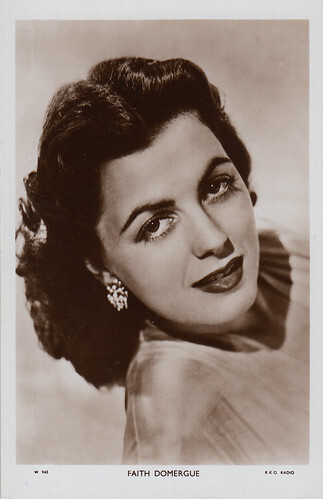
British postcard in the Picturegoer Series, London, no. W945. Photo: R.K.O. Radio.

British postcard in the Greetings series. Photo: R.K.O. Radio. Collection: Marlene Pilaete.
Groomed for stardom
She finally got tired of Hughes’ philandering and, in 1945, she began dating bandleader Teddy Stauffer, whom she married in January 1946. The romance between Hughes and Faith Domergue was over but their professional relationship didn’t end there.
She played a supporting part in Young Widow (1946), which starred Jane Russell , another Hughes protégée.
He then decided to groom her for stardom in a screen adaptation of Prosper Mérimée’s novel, 'Colomba'. It took several years to be completed. It was first started under the direction of Max Ophüls before Preston Sturges took over from him. Dissatisfied, Hughes then hired Stuart Heisler. In the end, it was Mel Ferrer who finished the movie, which was called Vendetta.
During filming, Faith Domergue, after her divorce from Stauffer, married director Hugo Fregonese in 1947. They had two children in 1949 and 1951 and divorced in 1958. In November 1950, audiences could at last see her in a leading role in the Film Noir Where Danger Lives, in which she co-starred with Robert Mitchum .
In December, Vendetta was eventually released but was not well-received. When tired and pregnant, she told the studio that she couldn’t go on to promote her two movies in New York, Howard Hughes suddenly lost interest in her and she never heard of him anymore.

Dutch postcard by Takken, no. A.X. 1753. Photo: R.K.O. Radio Films.
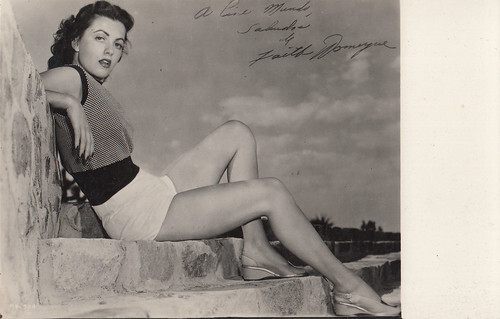
Spanish postcard by Cine Mundo.
Her post-Howard Hughes career
She pursued her career by being featured in Westerns such as The Duel at Silver Creek (1952), The Great Sioux Uprising (1953) and Santa Fe Passage (1955). In 1954, she played Linda Darnell ’s sister in This Is My Love (1954) and was then a mysterious lady who was able to transform herself into a snake in the Horror movie Cult of the Cobra (1955).
She is fondly remembered by Science-Fiction movie buffs for her role as a scientist in This Island Earth (1955). In the same vein, she had to cope with a giant radioactive octopus in It Came from Beneath the Sea (1955). She then went to Great Britain for Timeslip (1955) and also starred there in two crime dramas, Soho Incident (1956) and Man in the Shadow (1957). After an Italian movie, Il cielo brucia (1958), she came back to Hollywood for the Western Escort West (1959), opposite Victor Mature .
At the end of the 1950s and the beginning of the 1960s, she was very active on TV before resuming her movie career with the Western California (1963). In 1965, she appeared in Voyage to the Prehistoric Planet. In fact, this was a 1962 Soviet movie called Planeta Bur whom Roger Corman had purchased the rights for the American market. To make the film more marketable for local audiences, he decided to incorporate new scenes filmed with Faith Domergue and Basil Rathbone .
In the last part of her career, she performed in several Italian movies such as Una sull’altra (1969) or L’uomo dagli occhi di ghiaccio (1971). In the U.S., she also starred in three low-budget Horror movies: Legacy of Blood (1971), The House of Seven Corpses (1974) and So Evil, My Sister (1974). Her filmography ended with the Italian film Amore grande, amore libero (1976).
In 1992, Faith Domergue was widowed from her third husband, Paolo Cossa, whom she had married in 1966. She spent the last years of her life with her daughter and passed away on the 4th of April 1999.
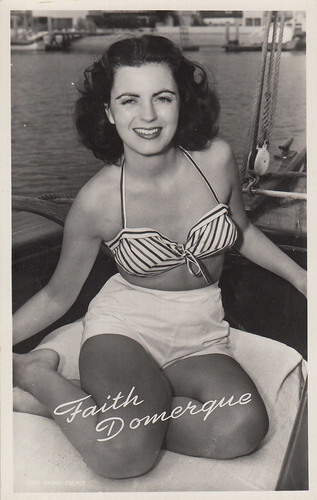
Dutch postcard by Takken, no. A.X. 828. Photo: RKO Radio Films.

Argentinian postcard by Cromocart G.W., no. 82. Photo: RKO Radio Films.
Text and postcards: Marlene Pilaete.

British postcard in the Picturegoer series, London, no. D197. Photo: R.K.O. Radio.

Dutch postcard by Takken, no. A.X. 1081. Photo: R.K.O. Radio Films.
Howard Hughes’ protégée
Faith Domergue was born on the 16th of June 1924 or 1925 in New Orleans, Louisiana, U.S.A. When she was six weeks old, she was adopted by Adabelle Wemet and, when she was eighteen months old, her adoptive mother married Leo Domergue.
The family soon moved to California and, at the beginning of the 1940s, Faith Domergue signed a contract with Warner Bros.
In 1941, she attended a party aboard Howard Hughes’s yacht. The wealthy businessman was immediately smitten with the pretty teenager. He began courting her and, in October 1941, he gave her an engagement ring. He also bought out her Warner Bros. contract.
They had an on-and-off relationship for several years. She was kept isolated by Hughes, who tried to exercise the most control he could on her life.
Faith allegedly said about this period of her life: "Suddenly, my professional and emotional future were completely in his hands".

British postcard in the Picturegoer Series, London, no. W945. Photo: R.K.O. Radio.

British postcard in the Greetings series. Photo: R.K.O. Radio. Collection: Marlene Pilaete.
Groomed for stardom
She finally got tired of Hughes’ philandering and, in 1945, she began dating bandleader Teddy Stauffer, whom she married in January 1946. The romance between Hughes and Faith Domergue was over but their professional relationship didn’t end there.
She played a supporting part in Young Widow (1946), which starred Jane Russell , another Hughes protégée.
He then decided to groom her for stardom in a screen adaptation of Prosper Mérimée’s novel, 'Colomba'. It took several years to be completed. It was first started under the direction of Max Ophüls before Preston Sturges took over from him. Dissatisfied, Hughes then hired Stuart Heisler. In the end, it was Mel Ferrer who finished the movie, which was called Vendetta.
During filming, Faith Domergue, after her divorce from Stauffer, married director Hugo Fregonese in 1947. They had two children in 1949 and 1951 and divorced in 1958. In November 1950, audiences could at last see her in a leading role in the Film Noir Where Danger Lives, in which she co-starred with Robert Mitchum .
In December, Vendetta was eventually released but was not well-received. When tired and pregnant, she told the studio that she couldn’t go on to promote her two movies in New York, Howard Hughes suddenly lost interest in her and she never heard of him anymore.

Dutch postcard by Takken, no. A.X. 1753. Photo: R.K.O. Radio Films.

Spanish postcard by Cine Mundo.
Her post-Howard Hughes career
She pursued her career by being featured in Westerns such as The Duel at Silver Creek (1952), The Great Sioux Uprising (1953) and Santa Fe Passage (1955). In 1954, she played Linda Darnell ’s sister in This Is My Love (1954) and was then a mysterious lady who was able to transform herself into a snake in the Horror movie Cult of the Cobra (1955).
She is fondly remembered by Science-Fiction movie buffs for her role as a scientist in This Island Earth (1955). In the same vein, she had to cope with a giant radioactive octopus in It Came from Beneath the Sea (1955). She then went to Great Britain for Timeslip (1955) and also starred there in two crime dramas, Soho Incident (1956) and Man in the Shadow (1957). After an Italian movie, Il cielo brucia (1958), she came back to Hollywood for the Western Escort West (1959), opposite Victor Mature .
At the end of the 1950s and the beginning of the 1960s, she was very active on TV before resuming her movie career with the Western California (1963). In 1965, she appeared in Voyage to the Prehistoric Planet. In fact, this was a 1962 Soviet movie called Planeta Bur whom Roger Corman had purchased the rights for the American market. To make the film more marketable for local audiences, he decided to incorporate new scenes filmed with Faith Domergue and Basil Rathbone .
In the last part of her career, she performed in several Italian movies such as Una sull’altra (1969) or L’uomo dagli occhi di ghiaccio (1971). In the U.S., she also starred in three low-budget Horror movies: Legacy of Blood (1971), The House of Seven Corpses (1974) and So Evil, My Sister (1974). Her filmography ended with the Italian film Amore grande, amore libero (1976).
In 1992, Faith Domergue was widowed from her third husband, Paolo Cossa, whom she had married in 1966. She spent the last years of her life with her daughter and passed away on the 4th of April 1999.

Dutch postcard by Takken, no. A.X. 828. Photo: RKO Radio Films.

Argentinian postcard by Cromocart G.W., no. 82. Photo: RKO Radio Films.
Text and postcards: Marlene Pilaete.
Published on November 29, 2023 22:00
November 28, 2023
La fiaccola sotto il moggio (1916)
Polish singer and actress Helena/Elena Makowska (1893-1964) starred as the evil Angizia in the Italian silent film La fiaccola sotto il moggio/The Torch under the Bushel (Eleuterio Rodolfi, 1916). The Ambrosio production was an adaptation of the eponymous stage play by Gabriele D'Annunzio (1905). Ivo Blom collected the complete set of Italian postcards that was published to promote the film, with the original envelope included.

Italian postcard. Photo: Ambrosio. Anna De Marco as Gigliola in La fiaccola sotto il moggio/The Torch under the Bushel (Eleuterio Rodolfi, 1916). Caption: "All was dark. An unrelenting scourge scatters in the night the trembling survivors. Blessed is the one who rests in peace!" The vengeful Gigliola visits the grave of her mother in the family chapel, one year after the murder. She holds a wreath in her hands.
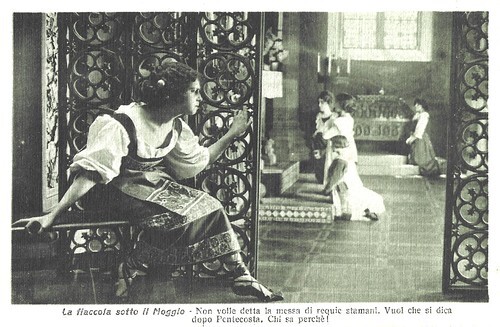
Italian postcard by Duplex IPA CT. V. Uff. Rev. St. Terni, card 1 of 10, no. 3885. Photo: Film. Soc. An. Ambrosio, Torino. Helena Makowska as Angizia in La fiaccola sotto il moggio/The Torch under the Bushel (Eleuterio Rodolfi, 1916). Caption: She didn't want the requiem mass to be celebrated today. She wants to do it after Pentecost. Who knows why? [Angizia watches the Di Sangro family attending mass].
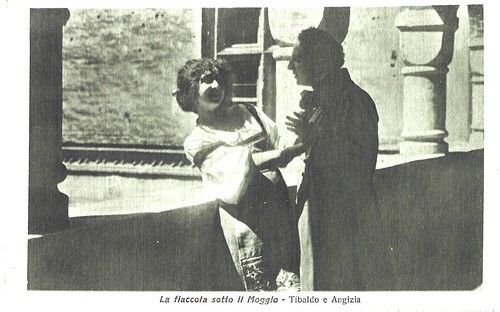
Italian postcard by Duplex IPA CT. V. Uff. Rev. St. Terni, card 2 of 10, no. 3887. Photo: Film. Soc. An. Ambrosio, Torino. Helena Makowska as Angizia and Umberto Mozzato as Tibaldo in La fiaccola sotto il moggio/The Torch under the Bushel (Eleuterio Rodolfi, 1916). Caption: Tibaldo and Angizia.
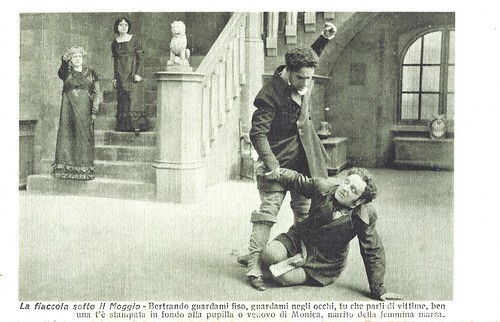
Italian postcard by Duplex IPA CT. V. Uff. Rev. St. Terni, card 3 of 10, no. 3889. Photo: Film. Soc. An. Ambrosio, Torino. Scene from La fiaccola sotto il moggio/The Torch under the Bushel (Eleuterio Rodolfi, 1916). Caption: Bertrando to Tibaldo: Look at me closely, look me in the eyes, you who speaks of victims. Well, one for sure is printed to the back of your eye, you widower of Monica, and husband of the woman of the marshes. [Gigliola and Donna Aldegrina witness a fight between the two stepbrothers].
A desire for revenge grows in the mind of the young girl
La fiaccola sotto il moggio/The Torch under the Bushel (Eleuterio Rodolfi, 1916) tells the decadent noble family Di Sangro. The family lives in a decrepit castle in the Abruzzi. Gigliola (Anna De Marco) hates her stepmother Angizia ( Helena Makowska ), a former servant of the family who in order to be able to marry Gigliola's father, Tibaldo (Umberto Mozzato), seduced him and killed his first wife, Monica ( Linda Pini ).
A desire for revenge grows in the mind of the young girl, only to be fulfilled by killing the perfidious intruder. Before committing her 'justice', she takes poison to atone for the act she is about to commit. But the evil woman is already dead: it is Tibaldo who has preceded his daughter when finding out about his second wife's infidelity and murder. Gigliola dies on her mother's grave, despairing she has been unable to finish her revenge.
Gabriele D'Annunzio 's original tale has a partly different plot. Here the point of departure is that the family of Tibaldo and his new wife suffers from moral and physical decadence. A snake breeder, Angizia's father, is hosted by the family but then chased by his daughter, but not before he has cursed her.
Gigliola has managed to get the deadly vipers and be bitten. But before she can act she finds that her father has killed Angizia in order to save his daughter purity but also to atone for his own complicity in killing his wife.
Yet, Italian Wikipedia states an even different, drastic ending: Gigliola dies but also causes the entire decrepit family castle to collapse, giving her father a heart attack and Angizia a defacement. This plot is not confirmed in other sources and it is not visible in the existing print, held by the Museo Nazionale del Cinema. The title of the play and film refers to an Italian expression, meaning being in the possession of a hidden truth.
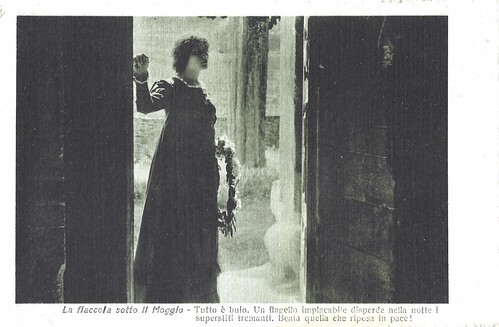
Italian postcard by Duplex IPA CT. V. Uff. Rev. St. Terni, card 4 of 10, no. 3886. Photo: Film. Soc. An. Ambrosio, Torino. Anna De Marco as Gigliola in La fiaccola sotto il moggio/The Torch under the Bushel (Eleuterio Rodolfi, 1916). Caption: All is dark. A relentless scourge scatters the trembling survivors in the night. Blessed is who rests in peace! [Monologue of Donna Aldegrina to her son Tibaldo.]
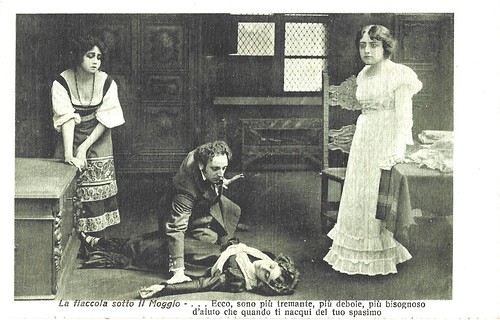
Italian postcard by Duplex IPA CT. V. Uff. Rev. St. Terni, card 5 of 10, no. 3884. Photo: Film. Soc. An. Ambrosio, Torino. Scene from La fiaccola sotto il moggio/The Torch under the Bushel (Eleuterio Rodolfi, 1916). Caption: Tibaldo to his mother, Donna Aldegrina: Look, am trembling, weaker and more helpless than when I was born from your spasms. [In the play, Angizia and Gigliola are not present when he says so. In this dialogue, Tibaldo confesses to his mother that Angizia has said to Gigliola that she killed her mother. When he afterwards tries to strangle Angizia, his mother holds him back].
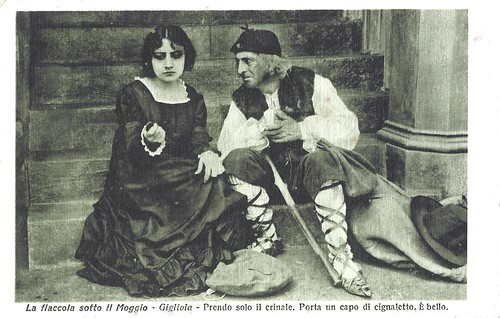
Italian postcard by Duplex IPA CT. V. Uff. Rev. St. Terni, card 6 of 10, no. 3882. Photo: Film. Soc. An. Ambrosio, Torino. Helena Makowska as Angizia in La fiaccola sotto il moggio/The Torch under the Bushel (Eleuterio Rodolfi, 1916). Caption: Gigliola: I will only take the dagger. It has a mockingbird's head. It is nice. [Yet, the snake catcher gives her also a bag with poisonous vipers].
Gorgeous tinting and toning in pink and blue for the night scenes
The film critic Tito Alacevich praised La fiaccola sotto il moggio/The Torch under the Bushel (Eleuterio Rodolfi, 1916), after Rodolfi's earlier adaptation of Gabriele D'Annunzio 's La Gioconda. He states that at the theatre the audience dislikes D'Annunzio's swollen language, but at the cinema, they just neglect the title cards and enjoy the plot and the characters.
Moreover, the critic praised the performances of the actors, in particular those of Helena Makowska , Anna De Marco and Umberto Mozzato. However, to our standards and compared to the other actors, Mozzato is rather overacting like he did in other films as well.
La fiaccola sotto il moggio/The Torch under the Bushel (Eleuterio Rodolfi, 1916) exists and has been restored by the Museo Nazionale del Cinema. It has gorgeous tinting and toning in pink and blue for the night scenes and shows some interesting exteriors such as the facade of a late medieval castle, a courtyard with heavy columns, etc.
The film was shown at the Cinema Ritrovato festival in Bologna in 2016, 100 years after its production. Italian film historian Claudia Gianetto has written about the film in the Cinema Ritrovato catalogue.
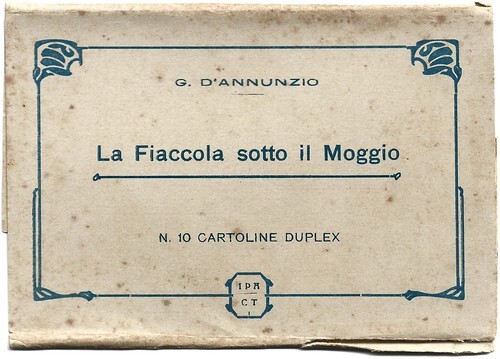
Vintage cover of Duplex card series of 10 cards (complete) by IPA CT.
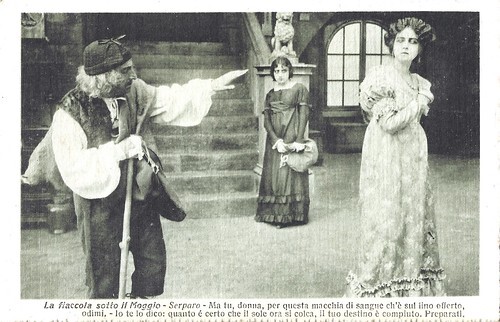
Italian postcard by Duplex IPA CT. V. Uff. Rev. St. Terni, card 7 of 10, no. 3883. Photo: Film. Soc. An. Ambrosio, Torino. Helena Makowska as Angizia and Filippo Butera as Serparao, her father, in La fiaccola sotto il moggio/The Torch under the Bushel (Eleuterio Rodolfi, 1916). Caption: Serparo: But you, woman, for this bloodstain on the offered linen, hate me. But I tell you: surely as soon as the sun sets, your destiny will be accomplished. Prepare yourself. [Anguzia's father, maltreated and chased by his own daughter, curses her].
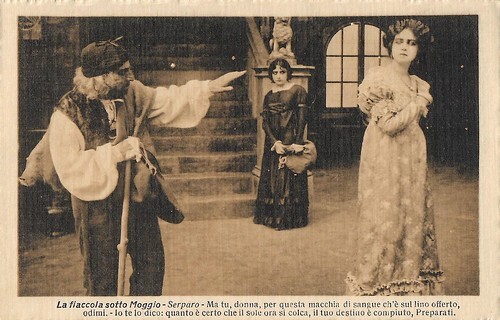
Italian postcard. Photo: Ambrosio. Helena Makowska as Angizia in La fiaccola sotto il moggio/The Torch under the Bushel (Eleuterio Rodolfi, 1916). The 'Serparo' (snake conjurer), played by Filippo Butera, curses his daughter Angizia ( Helena Makowska ): "You, woman, for this blood stain, which is on the offered linen, you may hate me. But I am telling you: as sure as the sun is now pouring, your destiny is fulfilled. Prepare yourself!" In the back, Angizia's stepdaughter Gigliola (Anna De Marco), suspects her stepmother has killed her mother to marry her father.
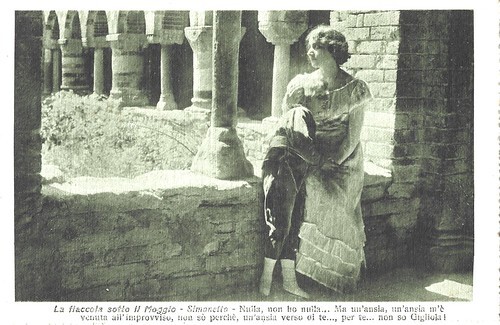
Italian postcard by Duplex IPA CT. V. Uff. Rev. St. Terni, card 8 of 10, no. 3890. Photo: Film. Soc. An. Ambrosio, Torino. Anna De Marco in La fiaccola sotto il moggio (Eleuterio Rodolfi, 1916). Caption: Simonetto: "Nothing, I have nothing... But I suddenly have such an anxiety, I don't know why, about you, for you, I don't know, Gigliola!"
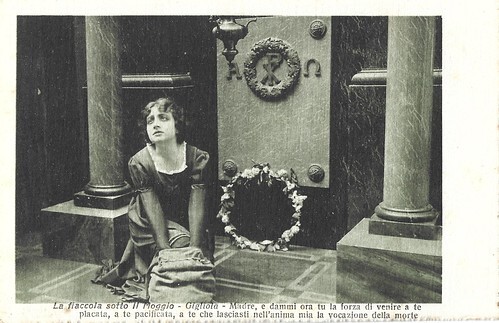
Italian postcard by Duplex IPA CT. V. Uff. Rev. St. Terni, card 9 of 10, no. 3891. Photo: Film. Soc. An. Ambrosio, Torino. Anna De Marco as Gigliola in La fiaccola sotto il moggio (Eleuterio Rodolfi, 1916). Caption: Gigliola: "Mother, give me now the strength to come to you pleased and pacified, to you who left in my soul the vocation of death". [Before her mother's tomb, Gigliola sticks her hands in the bag with the vipers, before killing her stepmother who killed her own mother]
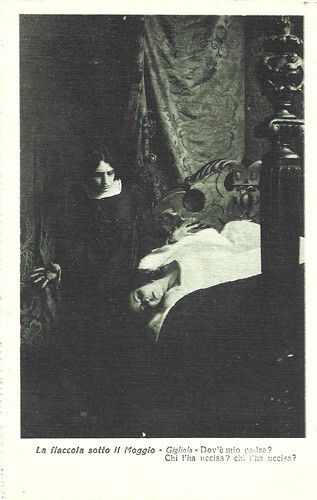
Italian postcard by Duplex IPA CT. V. Uff. Rev. St. Terni, card 10 of 10, no. 3883 (the series has 2x number 3883, so this may rather have been 3888). Photo: Film. Soc. An. Ambrosio, Torino. Anna De Marco in La fiaccola sotto il moggio (Eleuterio Rodolfi, 1916). Caption: Gigliola: Where is my father? Who killed her? Who killed her? [Gigliola is too late to kill her evil stepmother, as her father, overcome with remorse, has already done so].
Sources: Claudia Gianetto (Cinema Ritrovato catalogue), Wikipedia (Italian) and IMDb.

Italian postcard. Photo: Ambrosio. Anna De Marco as Gigliola in La fiaccola sotto il moggio/The Torch under the Bushel (Eleuterio Rodolfi, 1916). Caption: "All was dark. An unrelenting scourge scatters in the night the trembling survivors. Blessed is the one who rests in peace!" The vengeful Gigliola visits the grave of her mother in the family chapel, one year after the murder. She holds a wreath in her hands.

Italian postcard by Duplex IPA CT. V. Uff. Rev. St. Terni, card 1 of 10, no. 3885. Photo: Film. Soc. An. Ambrosio, Torino. Helena Makowska as Angizia in La fiaccola sotto il moggio/The Torch under the Bushel (Eleuterio Rodolfi, 1916). Caption: She didn't want the requiem mass to be celebrated today. She wants to do it after Pentecost. Who knows why? [Angizia watches the Di Sangro family attending mass].

Italian postcard by Duplex IPA CT. V. Uff. Rev. St. Terni, card 2 of 10, no. 3887. Photo: Film. Soc. An. Ambrosio, Torino. Helena Makowska as Angizia and Umberto Mozzato as Tibaldo in La fiaccola sotto il moggio/The Torch under the Bushel (Eleuterio Rodolfi, 1916). Caption: Tibaldo and Angizia.

Italian postcard by Duplex IPA CT. V. Uff. Rev. St. Terni, card 3 of 10, no. 3889. Photo: Film. Soc. An. Ambrosio, Torino. Scene from La fiaccola sotto il moggio/The Torch under the Bushel (Eleuterio Rodolfi, 1916). Caption: Bertrando to Tibaldo: Look at me closely, look me in the eyes, you who speaks of victims. Well, one for sure is printed to the back of your eye, you widower of Monica, and husband of the woman of the marshes. [Gigliola and Donna Aldegrina witness a fight between the two stepbrothers].
A desire for revenge grows in the mind of the young girl
La fiaccola sotto il moggio/The Torch under the Bushel (Eleuterio Rodolfi, 1916) tells the decadent noble family Di Sangro. The family lives in a decrepit castle in the Abruzzi. Gigliola (Anna De Marco) hates her stepmother Angizia ( Helena Makowska ), a former servant of the family who in order to be able to marry Gigliola's father, Tibaldo (Umberto Mozzato), seduced him and killed his first wife, Monica ( Linda Pini ).
A desire for revenge grows in the mind of the young girl, only to be fulfilled by killing the perfidious intruder. Before committing her 'justice', she takes poison to atone for the act she is about to commit. But the evil woman is already dead: it is Tibaldo who has preceded his daughter when finding out about his second wife's infidelity and murder. Gigliola dies on her mother's grave, despairing she has been unable to finish her revenge.
Gabriele D'Annunzio 's original tale has a partly different plot. Here the point of departure is that the family of Tibaldo and his new wife suffers from moral and physical decadence. A snake breeder, Angizia's father, is hosted by the family but then chased by his daughter, but not before he has cursed her.
Gigliola has managed to get the deadly vipers and be bitten. But before she can act she finds that her father has killed Angizia in order to save his daughter purity but also to atone for his own complicity in killing his wife.
Yet, Italian Wikipedia states an even different, drastic ending: Gigliola dies but also causes the entire decrepit family castle to collapse, giving her father a heart attack and Angizia a defacement. This plot is not confirmed in other sources and it is not visible in the existing print, held by the Museo Nazionale del Cinema. The title of the play and film refers to an Italian expression, meaning being in the possession of a hidden truth.

Italian postcard by Duplex IPA CT. V. Uff. Rev. St. Terni, card 4 of 10, no. 3886. Photo: Film. Soc. An. Ambrosio, Torino. Anna De Marco as Gigliola in La fiaccola sotto il moggio/The Torch under the Bushel (Eleuterio Rodolfi, 1916). Caption: All is dark. A relentless scourge scatters the trembling survivors in the night. Blessed is who rests in peace! [Monologue of Donna Aldegrina to her son Tibaldo.]

Italian postcard by Duplex IPA CT. V. Uff. Rev. St. Terni, card 5 of 10, no. 3884. Photo: Film. Soc. An. Ambrosio, Torino. Scene from La fiaccola sotto il moggio/The Torch under the Bushel (Eleuterio Rodolfi, 1916). Caption: Tibaldo to his mother, Donna Aldegrina: Look, am trembling, weaker and more helpless than when I was born from your spasms. [In the play, Angizia and Gigliola are not present when he says so. In this dialogue, Tibaldo confesses to his mother that Angizia has said to Gigliola that she killed her mother. When he afterwards tries to strangle Angizia, his mother holds him back].

Italian postcard by Duplex IPA CT. V. Uff. Rev. St. Terni, card 6 of 10, no. 3882. Photo: Film. Soc. An. Ambrosio, Torino. Helena Makowska as Angizia in La fiaccola sotto il moggio/The Torch under the Bushel (Eleuterio Rodolfi, 1916). Caption: Gigliola: I will only take the dagger. It has a mockingbird's head. It is nice. [Yet, the snake catcher gives her also a bag with poisonous vipers].
Gorgeous tinting and toning in pink and blue for the night scenes
The film critic Tito Alacevich praised La fiaccola sotto il moggio/The Torch under the Bushel (Eleuterio Rodolfi, 1916), after Rodolfi's earlier adaptation of Gabriele D'Annunzio 's La Gioconda. He states that at the theatre the audience dislikes D'Annunzio's swollen language, but at the cinema, they just neglect the title cards and enjoy the plot and the characters.
Moreover, the critic praised the performances of the actors, in particular those of Helena Makowska , Anna De Marco and Umberto Mozzato. However, to our standards and compared to the other actors, Mozzato is rather overacting like he did in other films as well.
La fiaccola sotto il moggio/The Torch under the Bushel (Eleuterio Rodolfi, 1916) exists and has been restored by the Museo Nazionale del Cinema. It has gorgeous tinting and toning in pink and blue for the night scenes and shows some interesting exteriors such as the facade of a late medieval castle, a courtyard with heavy columns, etc.
The film was shown at the Cinema Ritrovato festival in Bologna in 2016, 100 years after its production. Italian film historian Claudia Gianetto has written about the film in the Cinema Ritrovato catalogue.

Vintage cover of Duplex card series of 10 cards (complete) by IPA CT.

Italian postcard by Duplex IPA CT. V. Uff. Rev. St. Terni, card 7 of 10, no. 3883. Photo: Film. Soc. An. Ambrosio, Torino. Helena Makowska as Angizia and Filippo Butera as Serparao, her father, in La fiaccola sotto il moggio/The Torch under the Bushel (Eleuterio Rodolfi, 1916). Caption: Serparo: But you, woman, for this bloodstain on the offered linen, hate me. But I tell you: surely as soon as the sun sets, your destiny will be accomplished. Prepare yourself. [Anguzia's father, maltreated and chased by his own daughter, curses her].

Italian postcard. Photo: Ambrosio. Helena Makowska as Angizia in La fiaccola sotto il moggio/The Torch under the Bushel (Eleuterio Rodolfi, 1916). The 'Serparo' (snake conjurer), played by Filippo Butera, curses his daughter Angizia ( Helena Makowska ): "You, woman, for this blood stain, which is on the offered linen, you may hate me. But I am telling you: as sure as the sun is now pouring, your destiny is fulfilled. Prepare yourself!" In the back, Angizia's stepdaughter Gigliola (Anna De Marco), suspects her stepmother has killed her mother to marry her father.

Italian postcard by Duplex IPA CT. V. Uff. Rev. St. Terni, card 8 of 10, no. 3890. Photo: Film. Soc. An. Ambrosio, Torino. Anna De Marco in La fiaccola sotto il moggio (Eleuterio Rodolfi, 1916). Caption: Simonetto: "Nothing, I have nothing... But I suddenly have such an anxiety, I don't know why, about you, for you, I don't know, Gigliola!"

Italian postcard by Duplex IPA CT. V. Uff. Rev. St. Terni, card 9 of 10, no. 3891. Photo: Film. Soc. An. Ambrosio, Torino. Anna De Marco as Gigliola in La fiaccola sotto il moggio (Eleuterio Rodolfi, 1916). Caption: Gigliola: "Mother, give me now the strength to come to you pleased and pacified, to you who left in my soul the vocation of death". [Before her mother's tomb, Gigliola sticks her hands in the bag with the vipers, before killing her stepmother who killed her own mother]

Italian postcard by Duplex IPA CT. V. Uff. Rev. St. Terni, card 10 of 10, no. 3883 (the series has 2x number 3883, so this may rather have been 3888). Photo: Film. Soc. An. Ambrosio, Torino. Anna De Marco in La fiaccola sotto il moggio (Eleuterio Rodolfi, 1916). Caption: Gigliola: Where is my father? Who killed her? Who killed her? [Gigliola is too late to kill her evil stepmother, as her father, overcome with remorse, has already done so].
Sources: Claudia Gianetto (Cinema Ritrovato catalogue), Wikipedia (Italian) and IMDb.
Published on November 28, 2023 22:00
November 27, 2023
Fernand Herrmann
Fernand Herrmann (1886–1944) or Fernand Hermann was a French silent film actor, who started his film career at Gaumont in 1911. He starred in some 26 films between 1914 and 1925. Herrmann is particularly known for the crime serials by Louis Feuillade for Gaumont, such as Les Vampires (1915) in which he played the double roles of Moréno and Brichonnet, and Barrabas (1920) in which he played the lawyer Jacques Varese.
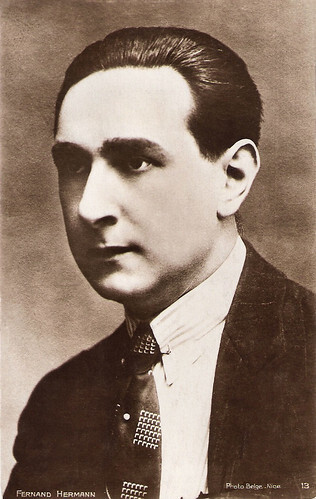
French postcard by Cinémagazine-Edition, no. 13. Photo: Belge, Nice.
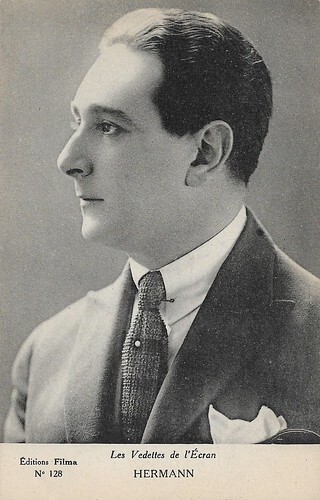
French postcard in the Les Vedettes de l'Ecran series by Editions Filma, no. 128.
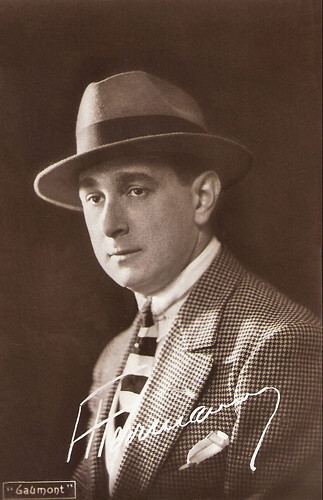
French postcard. Photo: Film Gaumont.
Head of a ring of crooks
Fernand Herrmann was born in 1886 in Paris, France. He was the son of Léon Herrmann and Mathilde Schmoll. His father was a painter, and his mother had no occupation. A child with a passion for the circus, he dreamed of becoming a horseman or acrobat. As a teenager, he attended many of the classic plays performed at the Comédie-Française. He then decided to become an actor, taking diction classes before joining Charles Le Bargy 's class at the Conservatoire.
After graduating with a first prize in comedy and a second prize in tragedy in 1907, Fernand Herrmann entered the Odéon, where he was mainly cast in roles of young actors. Two years later, he was hired by Sarah Bernhardt , in the troupe of the theatre that bears her name. He partnered the great actress in such plays as 'Le procès de Jeanne d'Arc' by Emile Moreau, 'L'aiglon' by Edmond Rostand, 'Les bouffons' by Miguel Zamacoïs and 'La dame aux camélias' by Alexandre Dumas fils . Just before the First World War, he also appeared in several plays at the Comédie des Champs-Élysées.
In the meantime, Fernand Herrmann had developed a keen interest in the cinema and was enthralled by the films he discovered. One of his first films for Gaumont was the short thriller Le trust, ou les batailles de l'argent/Trust (Louis Feuillade, 1911) in which a young inventor discovers a way to develop rubber in a more cost-friendly way. When he's on his way back to his boss with the new formula, he's kidnapped by his company's rival who wants the formula for himself. Such Gaumont regulars as Renee Carl, Jean Devalde and Rene Navarre were in the cast and Herrmann played an accomplice.
In the following years, he appeared for Gaumont in such films as Le calvaire (Louis Feuillade, 1914) and Severo Torelli (Louis Feuillade, 1914). While Fernand Herrmann played the title role in Severo Tortelli and the female lead was for Renée Carl (Dona Pia), actress Musidora (Portia) had one of her first film parts in this film, based on a play (1883) by François Coppée. Supporting actors were a.o. Jehan le Gall, Louise Lagrange and Georges Melchior .
He became known for the serial Les vampires/The Vampires (Louis Feuillade, 1915-1916), in which Herrmann played Juan-José Moréno (and Brichonnet), head of a ring of crooks rival to the Vampires. Moréno possesses a hypnotic gaze that he uses to control people. The serial established the genre of crime thriller, creating cinematic thriller techniques used later by Alfred Hitchcock and Fritz Lang . The use of gadgetry such as cannons and bombs was also adopted by Lang in films such as Dr. Mabuse, der Spieler/Dr. Mabuse the Gambler (Fritz Lang, 1922). He played the leading role in another Feuillade serial, Barrabas (Louis Feuillade, 1919). as lawyer Jacques Varese. Together with journalist Raoul de Nerac ( Édouard Mathé ), Varese attempts in this serial to expose and destroy the criminal organisation led by a sadistic banker Rudolph Strelitz (Gaston Michel), known as 'Barrabas'.
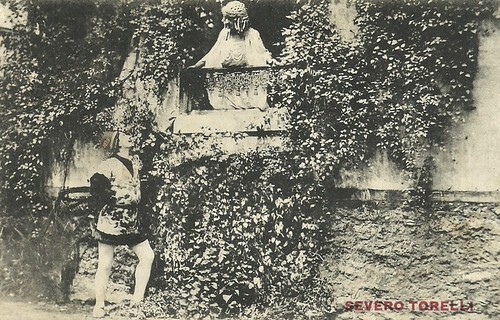
French postcard by Maury's International Attraction Circuit. Photo: Gaumont. Fernand Herrmann and Renée Carl in Severo Torelli (Louis Feuillade, 1914).
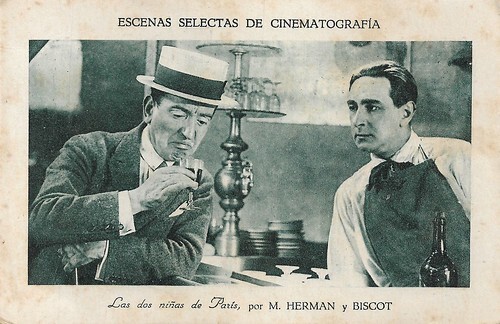
Spanish collectors card in the Escenas selectas de cinematografía, Series, B, No. 20. Photo: Gaumont. Georges Biscot and Fernand Herrmann in Les deux gamines/The two kids (Louis Feuillade, 1921), presented in Spain as Las dos niñas de París.
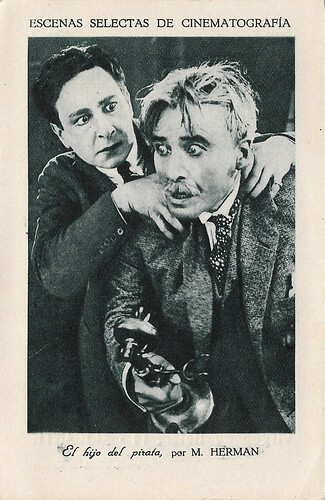
Spanish minicard in the Escenas selectas de cinematografía series, series B, no. 3, for Juan Garcia, Chocolates Gavilan, Alicante. Fernand Herrmann and Bernard Derigal in Le fils du flibustier/The buccaneer's son (Louis Feuillade, 1922). The Spanish title is El hijo del pirata.
Decency and morality were the order of the day
After World War I, Fernand Herrmann remained one of the permanent cast members of Louis Feuillade. With the return of peace, decency and morality were the order of the day. The Feuillade serials of the new decade leaned clearly towards melodrama. Triumphant crime gave way to persecuted innocence and family life. In Les Deux Gamines (Louis Feuillade, 1921), Fernand Herrmann played the father of Ginette ( Sandra Milowanoff ) and Gaby (Olinda Mano). Les Deux Gamines, presented at the Gaumont-Palace from January to April 1921, was acclaimed by the public.
Feuillade's subsequent serials, such as L'orpheline (Louis Feuillade, 1921) starring Sandra Milowanoff , Parisette (Louis Feuillade, 1921) and Le fils du flibustier (Louis Feuillade, 1922) starring Aimé Simon-Girard were always received with great favour by the public. But they were not such a triumph as Les Deux Gamines.
In 1923, the film serial craze began to fade. Vindicata (Louis Feuillade, 1923), set in 18th-century Provence and the Islands, has just five "episodes". The star of the series was comedian Georges Biscot and Herrmann only had a supporting part. In L'orphelin de Paris (Louis Feuillade, 1924), Hertmann appeared with two child stars, the seven-year-old girl Bouboule, and her partner René Poyen , ex-Bout-de-Zan who had become a teenager.
Feuillade was exhausted by a lifetime of uninterrupted work. He was forced to take a complete rest in the summer of 1924 and died the following year. Fernand Hermann continued to make films but now with director Georges Monca, including La double existence de Lord Samsey (Maurice Kéroul, Georges Monca, 1924) with Geneviève Félix . His final film was L'espionne aux yeux noirs (Henri Desfontaines, 1926) with Maria Dalbaicin in the title role. Herrmann retired from the cinema for good.
According to IMDb , Fernand Herrmann passed away in 1925. However, Pascal Donald at CinéArtistes shows sources that Herrmann died in 1944 in his hometown Paris. He was 58 and forgotten. Herrmann was the widower of soprano Angèle Grill, who had died a few months after their marriage in 1920 and was divorced from actress Hélène Barretta (1908-1922).
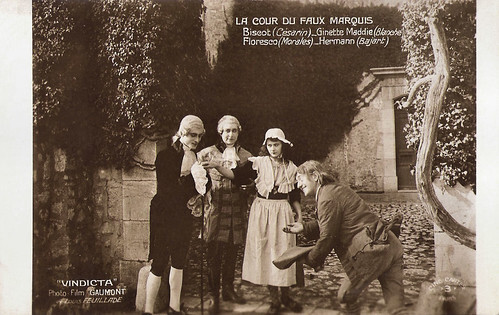
French postcard by Ciné Cartes, Paris, no. 3. Photo: Film Gaumont. Georges Biscot as Césarin at right, Ginette Maddie as Blanche, Michel Floresco as Morales at left and Fernand Hermann as Bajart in Vindicta (Louis Feuillade, 1923). Caption: La cour du faux marquis (The court of the false marquis).
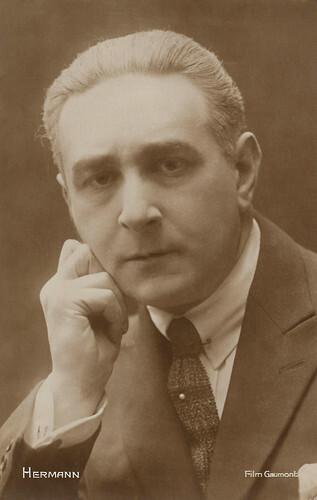
French postcard. Photo: Film Gaumont.
Sources: Pascal Donald (CinéArtistes - French), Wikipedia (French and English) and .

French postcard by Cinémagazine-Edition, no. 13. Photo: Belge, Nice.

French postcard in the Les Vedettes de l'Ecran series by Editions Filma, no. 128.

French postcard. Photo: Film Gaumont.
Head of a ring of crooks
Fernand Herrmann was born in 1886 in Paris, France. He was the son of Léon Herrmann and Mathilde Schmoll. His father was a painter, and his mother had no occupation. A child with a passion for the circus, he dreamed of becoming a horseman or acrobat. As a teenager, he attended many of the classic plays performed at the Comédie-Française. He then decided to become an actor, taking diction classes before joining Charles Le Bargy 's class at the Conservatoire.
After graduating with a first prize in comedy and a second prize in tragedy in 1907, Fernand Herrmann entered the Odéon, where he was mainly cast in roles of young actors. Two years later, he was hired by Sarah Bernhardt , in the troupe of the theatre that bears her name. He partnered the great actress in such plays as 'Le procès de Jeanne d'Arc' by Emile Moreau, 'L'aiglon' by Edmond Rostand, 'Les bouffons' by Miguel Zamacoïs and 'La dame aux camélias' by Alexandre Dumas fils . Just before the First World War, he also appeared in several plays at the Comédie des Champs-Élysées.
In the meantime, Fernand Herrmann had developed a keen interest in the cinema and was enthralled by the films he discovered. One of his first films for Gaumont was the short thriller Le trust, ou les batailles de l'argent/Trust (Louis Feuillade, 1911) in which a young inventor discovers a way to develop rubber in a more cost-friendly way. When he's on his way back to his boss with the new formula, he's kidnapped by his company's rival who wants the formula for himself. Such Gaumont regulars as Renee Carl, Jean Devalde and Rene Navarre were in the cast and Herrmann played an accomplice.
In the following years, he appeared for Gaumont in such films as Le calvaire (Louis Feuillade, 1914) and Severo Torelli (Louis Feuillade, 1914). While Fernand Herrmann played the title role in Severo Tortelli and the female lead was for Renée Carl (Dona Pia), actress Musidora (Portia) had one of her first film parts in this film, based on a play (1883) by François Coppée. Supporting actors were a.o. Jehan le Gall, Louise Lagrange and Georges Melchior .
He became known for the serial Les vampires/The Vampires (Louis Feuillade, 1915-1916), in which Herrmann played Juan-José Moréno (and Brichonnet), head of a ring of crooks rival to the Vampires. Moréno possesses a hypnotic gaze that he uses to control people. The serial established the genre of crime thriller, creating cinematic thriller techniques used later by Alfred Hitchcock and Fritz Lang . The use of gadgetry such as cannons and bombs was also adopted by Lang in films such as Dr. Mabuse, der Spieler/Dr. Mabuse the Gambler (Fritz Lang, 1922). He played the leading role in another Feuillade serial, Barrabas (Louis Feuillade, 1919). as lawyer Jacques Varese. Together with journalist Raoul de Nerac ( Édouard Mathé ), Varese attempts in this serial to expose and destroy the criminal organisation led by a sadistic banker Rudolph Strelitz (Gaston Michel), known as 'Barrabas'.

French postcard by Maury's International Attraction Circuit. Photo: Gaumont. Fernand Herrmann and Renée Carl in Severo Torelli (Louis Feuillade, 1914).

Spanish collectors card in the Escenas selectas de cinematografía, Series, B, No. 20. Photo: Gaumont. Georges Biscot and Fernand Herrmann in Les deux gamines/The two kids (Louis Feuillade, 1921), presented in Spain as Las dos niñas de París.

Spanish minicard in the Escenas selectas de cinematografía series, series B, no. 3, for Juan Garcia, Chocolates Gavilan, Alicante. Fernand Herrmann and Bernard Derigal in Le fils du flibustier/The buccaneer's son (Louis Feuillade, 1922). The Spanish title is El hijo del pirata.
Decency and morality were the order of the day
After World War I, Fernand Herrmann remained one of the permanent cast members of Louis Feuillade. With the return of peace, decency and morality were the order of the day. The Feuillade serials of the new decade leaned clearly towards melodrama. Triumphant crime gave way to persecuted innocence and family life. In Les Deux Gamines (Louis Feuillade, 1921), Fernand Herrmann played the father of Ginette ( Sandra Milowanoff ) and Gaby (Olinda Mano). Les Deux Gamines, presented at the Gaumont-Palace from January to April 1921, was acclaimed by the public.
Feuillade's subsequent serials, such as L'orpheline (Louis Feuillade, 1921) starring Sandra Milowanoff , Parisette (Louis Feuillade, 1921) and Le fils du flibustier (Louis Feuillade, 1922) starring Aimé Simon-Girard were always received with great favour by the public. But they were not such a triumph as Les Deux Gamines.
In 1923, the film serial craze began to fade. Vindicata (Louis Feuillade, 1923), set in 18th-century Provence and the Islands, has just five "episodes". The star of the series was comedian Georges Biscot and Herrmann only had a supporting part. In L'orphelin de Paris (Louis Feuillade, 1924), Hertmann appeared with two child stars, the seven-year-old girl Bouboule, and her partner René Poyen , ex-Bout-de-Zan who had become a teenager.
Feuillade was exhausted by a lifetime of uninterrupted work. He was forced to take a complete rest in the summer of 1924 and died the following year. Fernand Hermann continued to make films but now with director Georges Monca, including La double existence de Lord Samsey (Maurice Kéroul, Georges Monca, 1924) with Geneviève Félix . His final film was L'espionne aux yeux noirs (Henri Desfontaines, 1926) with Maria Dalbaicin in the title role. Herrmann retired from the cinema for good.
According to IMDb , Fernand Herrmann passed away in 1925. However, Pascal Donald at CinéArtistes shows sources that Herrmann died in 1944 in his hometown Paris. He was 58 and forgotten. Herrmann was the widower of soprano Angèle Grill, who had died a few months after their marriage in 1920 and was divorced from actress Hélène Barretta (1908-1922).

French postcard by Ciné Cartes, Paris, no. 3. Photo: Film Gaumont. Georges Biscot as Césarin at right, Ginette Maddie as Blanche, Michel Floresco as Morales at left and Fernand Hermann as Bajart in Vindicta (Louis Feuillade, 1923). Caption: La cour du faux marquis (The court of the false marquis).

French postcard. Photo: Film Gaumont.
Sources: Pascal Donald (CinéArtistes - French), Wikipedia (French and English) and .
Published on November 27, 2023 22:00
November 26, 2023
Alan Bates
British actor Alan Bates (1934-2003) forged his name on the West End stage in John Osborne's 'Look Back in Anger' in 1956. He also appeared in 50 films and 33 television productions, and for each role, he created a three-dimensional, unique person. With few exceptions, the talented and versatile Bates performed in premium works, guided by a pure love of acting rather than by box office.
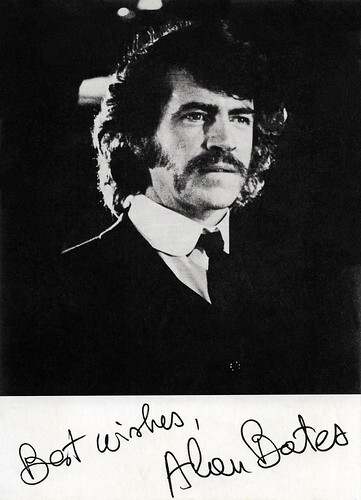
French postcard by La Roue Tourne, Paris. Photo: Alan Bates in The Go-Between (Joseph Losey, 1971).
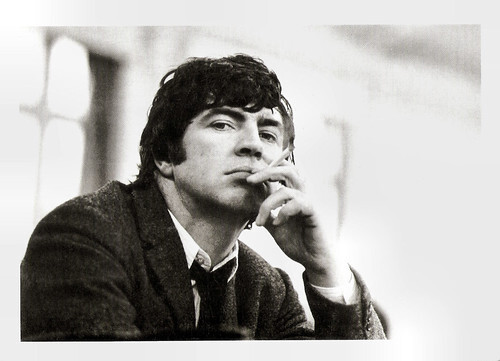
British postcard by NT (National Theatre) in the series 'Taking the Stage: an exhibition of photographs by John Haynes'. Photo: John Haynes. Alan Bates in the stage production of 'Butley' (1971) by Simon Gray at the Criterion Theatre.
Angry young men
Alan Arthur Bates was born in Allestree, England in 1934. He was the eldest of three sons of Florence Mary (née Wheatcroft), a homemaker and a pianist, and Harold Arthur Bates, an insurance broker and a cellist. Both of his parents were amateur musicians and encouraged him to pursue music, but at age 11, Alan decided to be an actor. After grammar school in Derbyshire, he earned a scholarship to the Royal Academy of Dramatic Arts in London.
Following two years in the Royal Air Force, he made his professional theatre debut with the Midland Theater Company in central England in 1955. He joined the new English Stage Company at the Royal Court Theatre, and at 22, he made his West End debut in 'The Mulberry Bush' (1956), which was also the company's first production. In the same year, Bates appeared in John Osborne's 'Look Back in Anger', a play that gave a name to a generation of postwar ‘angry young men’.
Along with Albert Finney , Richard Harris, Peter O'Toole and Tom Courtenay, Bates was one of the pioneers in the ‘kitchen sink’ drama revolution that overtook the London theatre in the 1950s: angry young men - writers, actors directors and their creations - rebelling against postwar England's middle-class values. 'Look Back in Anger' made Bates a star and launched a lifetime of his performing in works written by great modern playwrights - Harold Pinter, Simon Gray, Peter Shaffer and Tom Stoppard as well as such classic playwrights as Anton Chekhov, Henrik Ibsen, August Strindberg and William Shakespeare .
His film debut was playing one of Laurence Olivier ’s sons in The Entertainer (Tony Richardson, 1960). Bates played his first lead two years later in A Kind of Loving (John Schlesinger, 1962), where he and June Ritchie played a couple trapped in their working-class life in Manchester. He starred alongside Anthony Quinn as the young English writer, Basil, in the film for which he will always be remembered, Alexis Zorbas/Zorba the Greek (Michael Cacoyannis, 1964). Another popular success was the 'Swinging London' comedy-drama Georgy Girl (1966) with Lynn Redgrave.
Throughout the 1960s, he starred in several major films including as a fugitive in Whistle Down the Wind (Bryan Forbes, 1961), as a suburban social climber who doesn't stop at murder to secure Nothing But the Best (Clive Donner, 1964), in Le roi de coeur/King of Hearts (1966, Phillipe de Broca), and in Far From the Madding Crowd (John Schlesinger, 1967). His role opposite Dirk Bogarde in The Fixer (John Frankenheimer, 1968), based on a novel by Bernard Malamud, earned him an Academy Award nomination for Best Actor. In 1969, he became the first actor to do frontal nudity in a major studio film during an infamous wrestling session with Oliver Reed in Women in Love (Ken Russell, 1969).
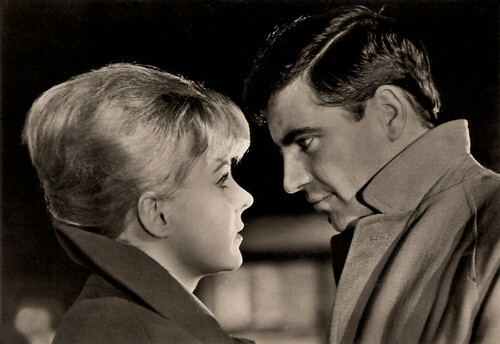
East-German postcard by VEB Progress Film-Vertrieb, Berlin, no. 1768, 1962. Retail price: 0,20 DM. Photo: Progress. Publicity still from A Kind of Loving (1962) with June Ritchie.
Versatility
Alan Bates began the subsequent decade on a very positive note, cast alongside Julie Christie as illicit lovers in The Go-Between (Joseph Losey, 1971). He was handpicked by director John Schlesinger to star in the film Sunday Bloody Sunday (1971) in the role of Dr. Daniel Hirsh. Bates was held up filming The Go-Between. He had also become a father around that time, and so he had to pass on the project. The part then went first to Ian Bannen, who balked at kissing and simulating sex with another man, and then to Peter Finch , who earned an Academy Award nomination for the role.
His versatility was again shown as the lead in Simon Gray's 'Butley', a stage comedy about an English literature professor's emotional and psychic disintegration. Bates originated the character on a London stage in 1971, did a reprise on Broadway in 1972, winning his first Tony Award, and played it again in a 1973 film. On stage, Bates had a particular association with the plays of Gray, also appearing in 'Otherwise Engaged', 'Stage Struck', 'Melon', 'Life Support' and 'Simply Disconnected'. In 'Otherwise Engaged', Bates' co-star was Ian Charleson, who became a good friend, and Bates later contributed a chapter to the 1990 book, 'For Ian Charleson: A Tribute'.
Bates would never attain the stardom of far lesser performers because of his preference for challenging and interesting work and avoidance of being type-cast. He continued to work in film and television throughout the 1970s and 1980s and starred in such international films as the dreamy fantasy The Shout (Jerzy Skolimowsk, 1978), as an intriguing but self-absorbed artist, Jill Clayburgh's bearded and ultimately spurned lover in An Unmarried Woman (Paul Mazursky, 1978), as Bette Midler's ruthless business manager The Rose (Mark Rydell, 1979), Nijinsky (1980), Britannia Hospital (Lindsay Anderson, 1984) and as Claudius in Hamlet (Franco Zeffirelli, 1990), which starred Mel Gibson .
Bryan McFarlane writes in Encyclopedia of British Cinema that "Bates went from strength to strength, even in films given the brush-off by the public: for example, the transferred stage successes, Butley (Harold Pinter, 1973) and In Celebration (Lindsay Anderson, 1974), or the undervalued Return of the Soldier (Alan Bridges, 1982)."
On television, his parts ranged from classic roles such as The Mayor of Casterbridge (1978, his favourite role he said), A Voyage Around My Father (1982), An Englishman Abroad (John Schlesinger, 1983) witty and painful as Guy Burgess, and Pack of Lies (1987) in which he played a Russian spy. He continued working in film and television in the 1990s, though most of his roles in this era were low-key.
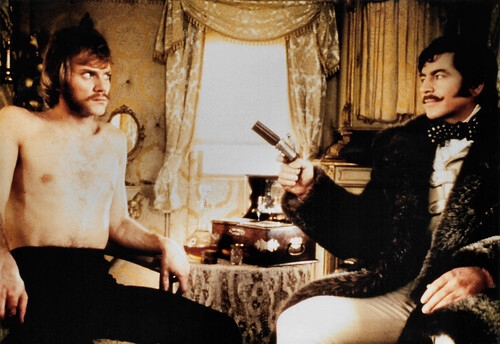
Vintage photo. Progress. Malcolm McDowell and Alan Bates in Royal Flash (Richard Lester, 1975).
A softer, still attractive maturity
In 2001, Alan Bates joined an all-star cast in Robert Altman's critically acclaimed period drama and murder mystery Gosford Park (Robert Altman, 2001), in which he played the butler Jennings bordering on breakdown. Then he appeared as a fascist who plots to bomb a Super Bowl game in the thriller The Sum of All Fears (2002), and as a mad scientist who foretells disaster in The Mothman Prophecies (Mark Pellington, 2002) starring Richard Gere .
The rumpled charm of his youth had weathered into a softer but still attractive (and still rumpled) maturity. He later played Antonius Agrippa in the TV film Spartacus (Robert Dornhelm, 2004), but died before it debuted. The film was dedicated to his memory and that of writer Howard Fast, who wrote the original novel that inspired the film Spartacus by Stanley Kubrick.
Bates had been made a Commander of the Order of the British Empire (CBE) in 1996 and was knighted in 2003. He was an Associate Member of RADA and was a patron of The Actors Centre in London from 1994 until his death in 2003. He won several theatre awards, including two Tony Awards.
Bates was married to actress and model Victoria Ward from 1970 until her death from a wasting disease in 1992. They had twin sons born in November 1970, the actors Benedick Bates and Tristan Bates. Tristan died following an asthma attack in 1990. In later years, Bates' companion was his lifelong friend, actress Joanna Pettet, his co-star in the 1964 Broadway play 'Poor Richard'. They divided their time between New York and London.
Bates had many relationships with men, including with actors Nickolas Grace and Peter Wyngarde, and Olympic skater John Curry. These were detailed in his posthumous biography, 'Otherwise Engaged' by Donald Spoto. Alan Bates died of pancreatic cancer in London in 2003. Sir Alan and his family set up the Tristan Bates Theatre at the Actors' Centre in Covent Garden, in memory of his son, Tristan, who died at the age of 19. Tristan's twin brother, Benedick, is a deputy director.
Trailer for The Shout (1978). Source: Passion4Horror (YouTube).
Trailer for Return of the Soldier (1982). Source: TapeSalvage (YouTube).
Sources: Brian McFarlane (Encyclopedia of British Cinema), Robert D. McFadden (The New York Times), (IMDb), (IMDb), BritMovie, Wikipedia, and .

French postcard by La Roue Tourne, Paris. Photo: Alan Bates in The Go-Between (Joseph Losey, 1971).

British postcard by NT (National Theatre) in the series 'Taking the Stage: an exhibition of photographs by John Haynes'. Photo: John Haynes. Alan Bates in the stage production of 'Butley' (1971) by Simon Gray at the Criterion Theatre.
Angry young men
Alan Arthur Bates was born in Allestree, England in 1934. He was the eldest of three sons of Florence Mary (née Wheatcroft), a homemaker and a pianist, and Harold Arthur Bates, an insurance broker and a cellist. Both of his parents were amateur musicians and encouraged him to pursue music, but at age 11, Alan decided to be an actor. After grammar school in Derbyshire, he earned a scholarship to the Royal Academy of Dramatic Arts in London.
Following two years in the Royal Air Force, he made his professional theatre debut with the Midland Theater Company in central England in 1955. He joined the new English Stage Company at the Royal Court Theatre, and at 22, he made his West End debut in 'The Mulberry Bush' (1956), which was also the company's first production. In the same year, Bates appeared in John Osborne's 'Look Back in Anger', a play that gave a name to a generation of postwar ‘angry young men’.
Along with Albert Finney , Richard Harris, Peter O'Toole and Tom Courtenay, Bates was one of the pioneers in the ‘kitchen sink’ drama revolution that overtook the London theatre in the 1950s: angry young men - writers, actors directors and their creations - rebelling against postwar England's middle-class values. 'Look Back in Anger' made Bates a star and launched a lifetime of his performing in works written by great modern playwrights - Harold Pinter, Simon Gray, Peter Shaffer and Tom Stoppard as well as such classic playwrights as Anton Chekhov, Henrik Ibsen, August Strindberg and William Shakespeare .
His film debut was playing one of Laurence Olivier ’s sons in The Entertainer (Tony Richardson, 1960). Bates played his first lead two years later in A Kind of Loving (John Schlesinger, 1962), where he and June Ritchie played a couple trapped in their working-class life in Manchester. He starred alongside Anthony Quinn as the young English writer, Basil, in the film for which he will always be remembered, Alexis Zorbas/Zorba the Greek (Michael Cacoyannis, 1964). Another popular success was the 'Swinging London' comedy-drama Georgy Girl (1966) with Lynn Redgrave.
Throughout the 1960s, he starred in several major films including as a fugitive in Whistle Down the Wind (Bryan Forbes, 1961), as a suburban social climber who doesn't stop at murder to secure Nothing But the Best (Clive Donner, 1964), in Le roi de coeur/King of Hearts (1966, Phillipe de Broca), and in Far From the Madding Crowd (John Schlesinger, 1967). His role opposite Dirk Bogarde in The Fixer (John Frankenheimer, 1968), based on a novel by Bernard Malamud, earned him an Academy Award nomination for Best Actor. In 1969, he became the first actor to do frontal nudity in a major studio film during an infamous wrestling session with Oliver Reed in Women in Love (Ken Russell, 1969).

East-German postcard by VEB Progress Film-Vertrieb, Berlin, no. 1768, 1962. Retail price: 0,20 DM. Photo: Progress. Publicity still from A Kind of Loving (1962) with June Ritchie.
Versatility
Alan Bates began the subsequent decade on a very positive note, cast alongside Julie Christie as illicit lovers in The Go-Between (Joseph Losey, 1971). He was handpicked by director John Schlesinger to star in the film Sunday Bloody Sunday (1971) in the role of Dr. Daniel Hirsh. Bates was held up filming The Go-Between. He had also become a father around that time, and so he had to pass on the project. The part then went first to Ian Bannen, who balked at kissing and simulating sex with another man, and then to Peter Finch , who earned an Academy Award nomination for the role.
His versatility was again shown as the lead in Simon Gray's 'Butley', a stage comedy about an English literature professor's emotional and psychic disintegration. Bates originated the character on a London stage in 1971, did a reprise on Broadway in 1972, winning his first Tony Award, and played it again in a 1973 film. On stage, Bates had a particular association with the plays of Gray, also appearing in 'Otherwise Engaged', 'Stage Struck', 'Melon', 'Life Support' and 'Simply Disconnected'. In 'Otherwise Engaged', Bates' co-star was Ian Charleson, who became a good friend, and Bates later contributed a chapter to the 1990 book, 'For Ian Charleson: A Tribute'.
Bates would never attain the stardom of far lesser performers because of his preference for challenging and interesting work and avoidance of being type-cast. He continued to work in film and television throughout the 1970s and 1980s and starred in such international films as the dreamy fantasy The Shout (Jerzy Skolimowsk, 1978), as an intriguing but self-absorbed artist, Jill Clayburgh's bearded and ultimately spurned lover in An Unmarried Woman (Paul Mazursky, 1978), as Bette Midler's ruthless business manager The Rose (Mark Rydell, 1979), Nijinsky (1980), Britannia Hospital (Lindsay Anderson, 1984) and as Claudius in Hamlet (Franco Zeffirelli, 1990), which starred Mel Gibson .
Bryan McFarlane writes in Encyclopedia of British Cinema that "Bates went from strength to strength, even in films given the brush-off by the public: for example, the transferred stage successes, Butley (Harold Pinter, 1973) and In Celebration (Lindsay Anderson, 1974), or the undervalued Return of the Soldier (Alan Bridges, 1982)."
On television, his parts ranged from classic roles such as The Mayor of Casterbridge (1978, his favourite role he said), A Voyage Around My Father (1982), An Englishman Abroad (John Schlesinger, 1983) witty and painful as Guy Burgess, and Pack of Lies (1987) in which he played a Russian spy. He continued working in film and television in the 1990s, though most of his roles in this era were low-key.

Vintage photo. Progress. Malcolm McDowell and Alan Bates in Royal Flash (Richard Lester, 1975).
A softer, still attractive maturity
In 2001, Alan Bates joined an all-star cast in Robert Altman's critically acclaimed period drama and murder mystery Gosford Park (Robert Altman, 2001), in which he played the butler Jennings bordering on breakdown. Then he appeared as a fascist who plots to bomb a Super Bowl game in the thriller The Sum of All Fears (2002), and as a mad scientist who foretells disaster in The Mothman Prophecies (Mark Pellington, 2002) starring Richard Gere .
The rumpled charm of his youth had weathered into a softer but still attractive (and still rumpled) maturity. He later played Antonius Agrippa in the TV film Spartacus (Robert Dornhelm, 2004), but died before it debuted. The film was dedicated to his memory and that of writer Howard Fast, who wrote the original novel that inspired the film Spartacus by Stanley Kubrick.
Bates had been made a Commander of the Order of the British Empire (CBE) in 1996 and was knighted in 2003. He was an Associate Member of RADA and was a patron of The Actors Centre in London from 1994 until his death in 2003. He won several theatre awards, including two Tony Awards.
Bates was married to actress and model Victoria Ward from 1970 until her death from a wasting disease in 1992. They had twin sons born in November 1970, the actors Benedick Bates and Tristan Bates. Tristan died following an asthma attack in 1990. In later years, Bates' companion was his lifelong friend, actress Joanna Pettet, his co-star in the 1964 Broadway play 'Poor Richard'. They divided their time between New York and London.
Bates had many relationships with men, including with actors Nickolas Grace and Peter Wyngarde, and Olympic skater John Curry. These were detailed in his posthumous biography, 'Otherwise Engaged' by Donald Spoto. Alan Bates died of pancreatic cancer in London in 2003. Sir Alan and his family set up the Tristan Bates Theatre at the Actors' Centre in Covent Garden, in memory of his son, Tristan, who died at the age of 19. Tristan's twin brother, Benedick, is a deputy director.
Trailer for The Shout (1978). Source: Passion4Horror (YouTube).
Trailer for Return of the Soldier (1982). Source: TapeSalvage (YouTube).
Sources: Brian McFarlane (Encyclopedia of British Cinema), Robert D. McFadden (The New York Times), (IMDb), (IMDb), BritMovie, Wikipedia, and .
Published on November 26, 2023 22:00
Paul van Yperen's Blog
- Paul van Yperen's profile
- 13 followers
Paul van Yperen isn't a Goodreads Author
(yet),
but they
do have a blog,
so here are some recent posts imported from
their feed.



